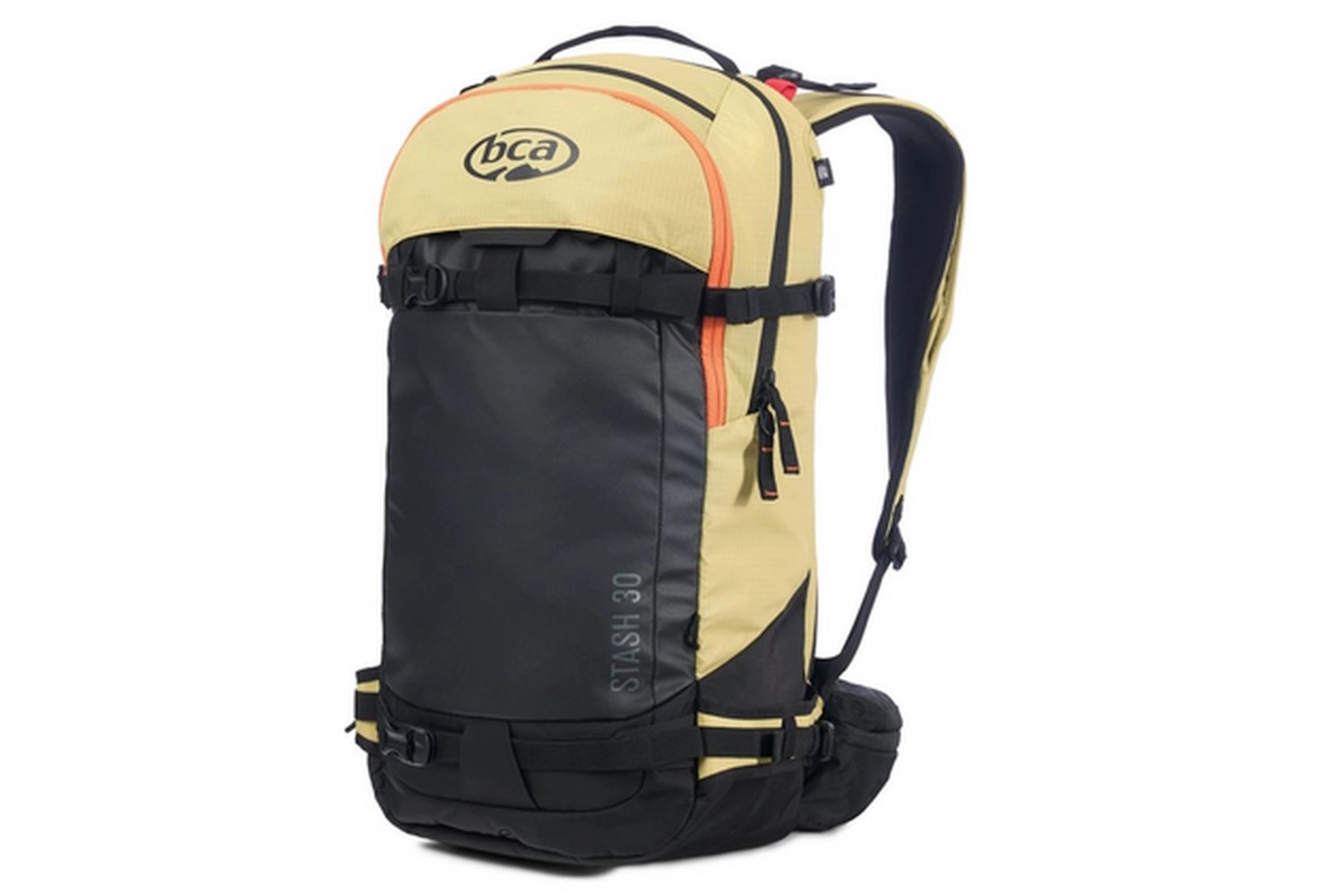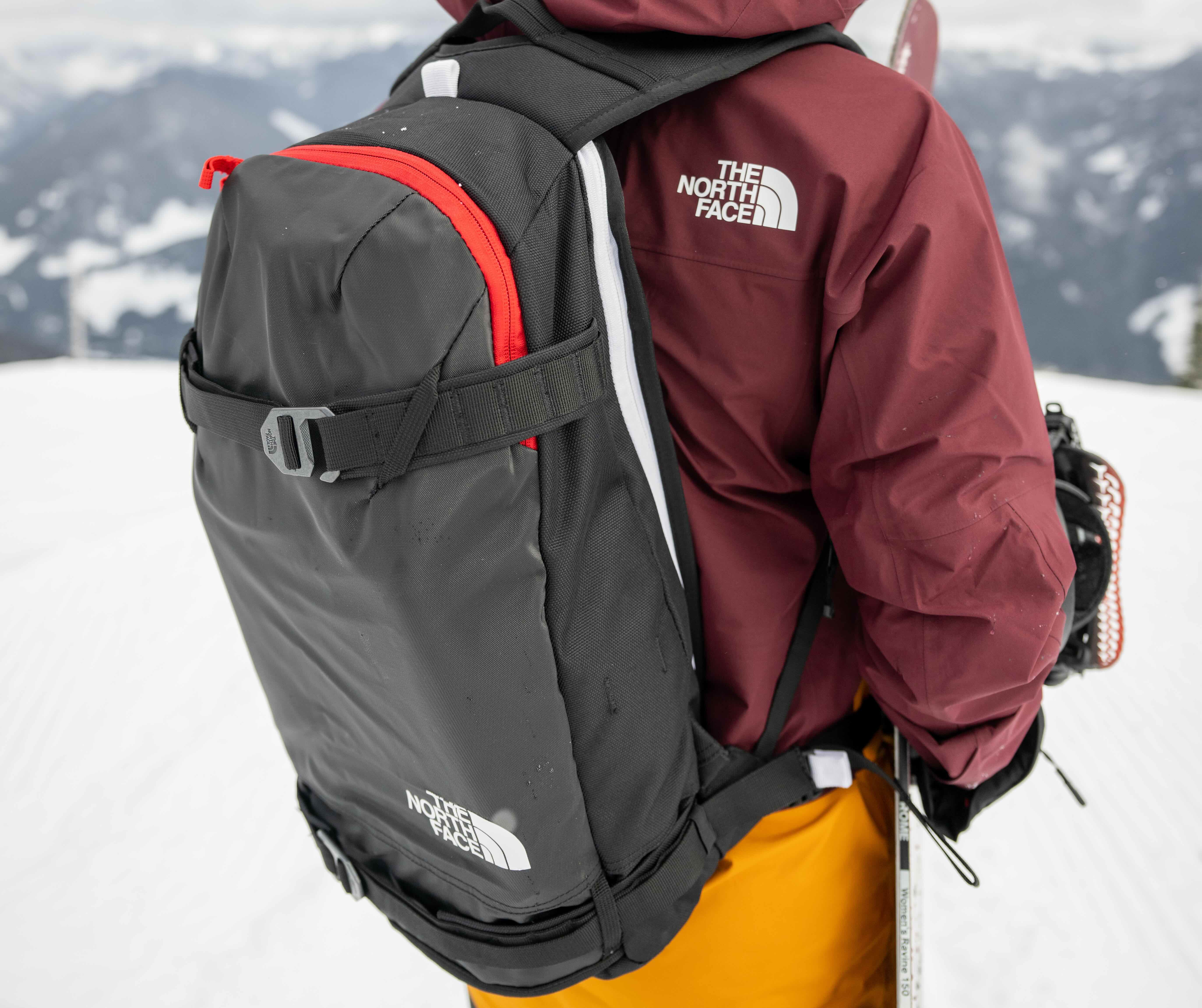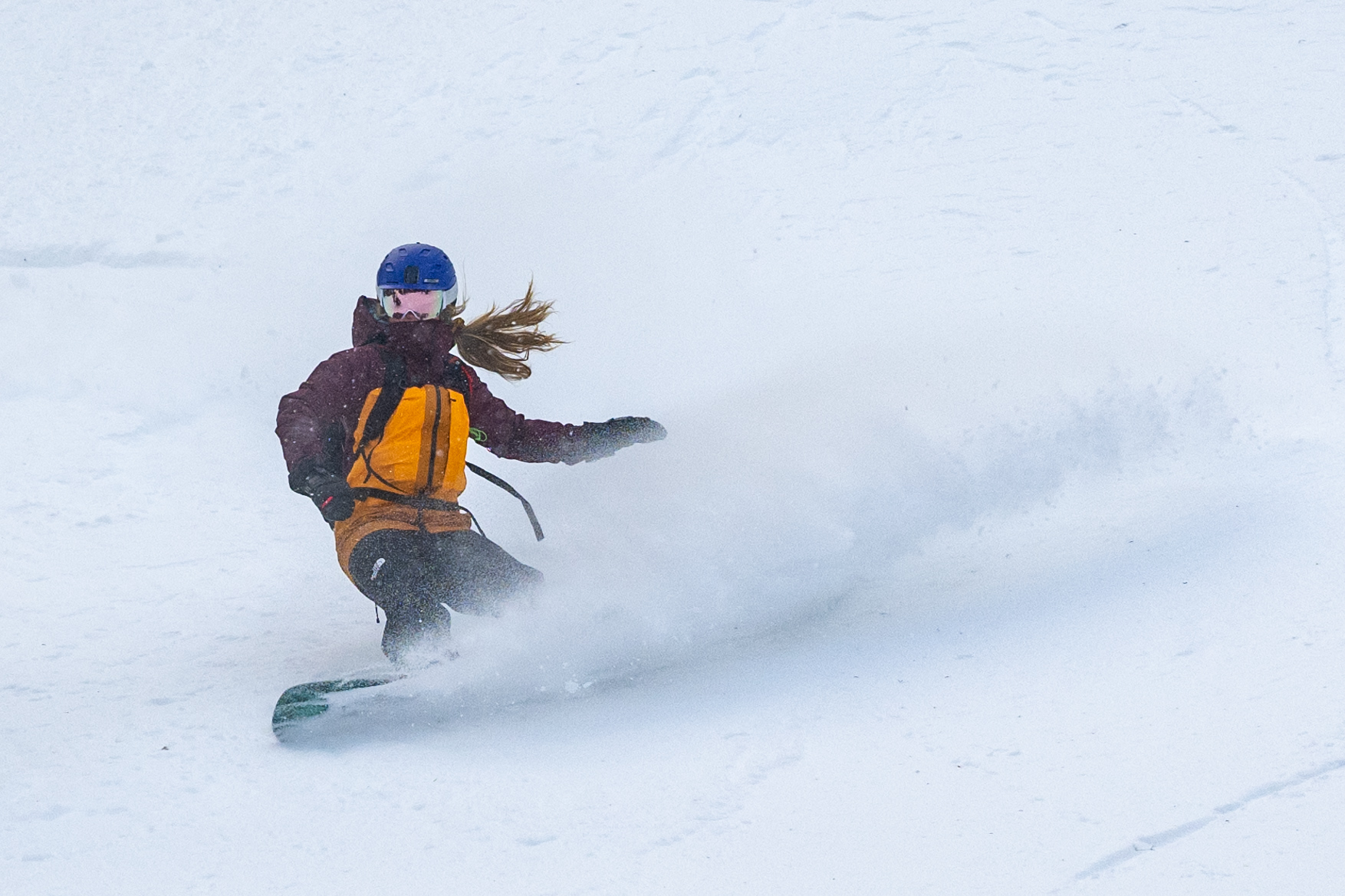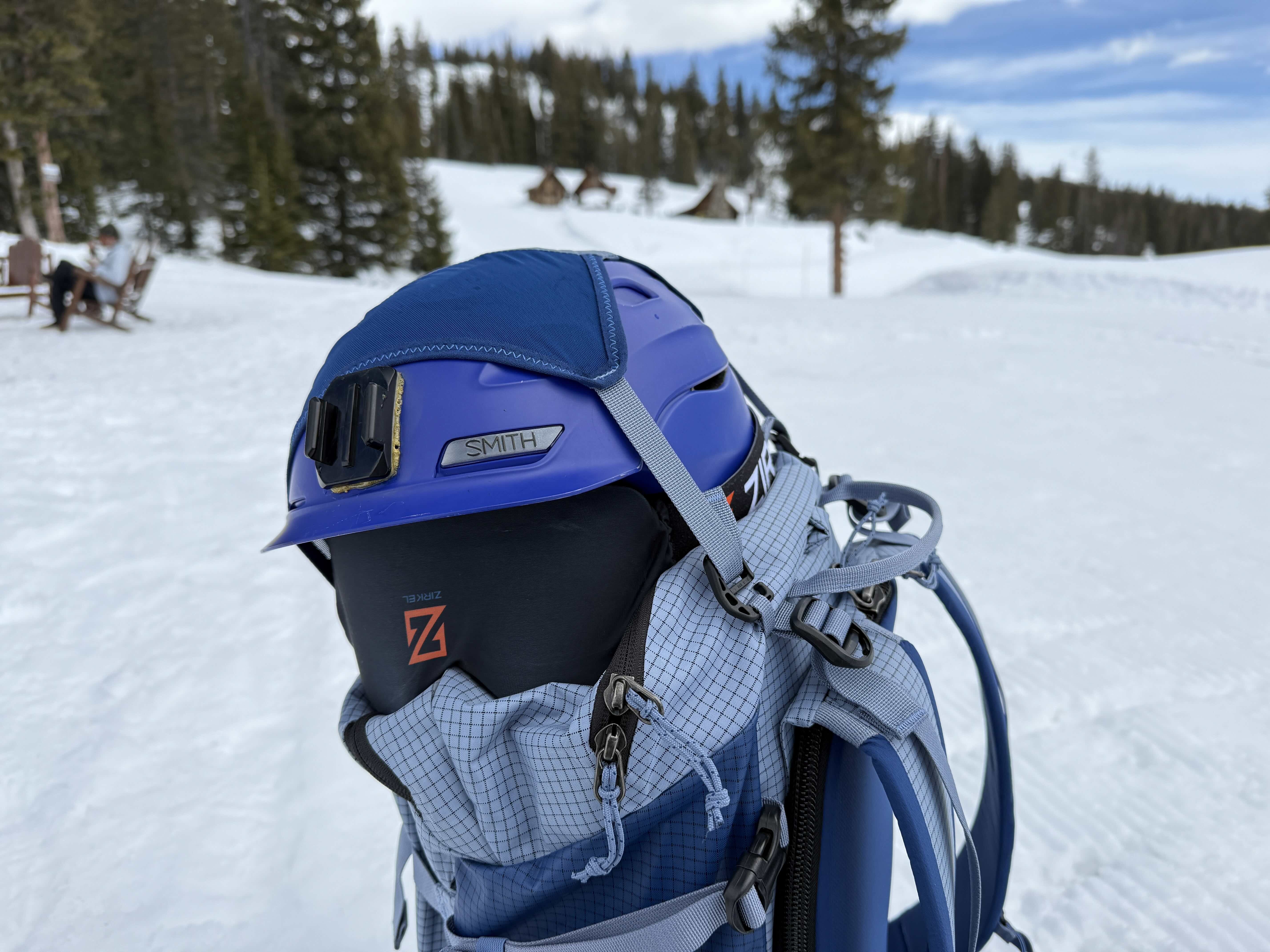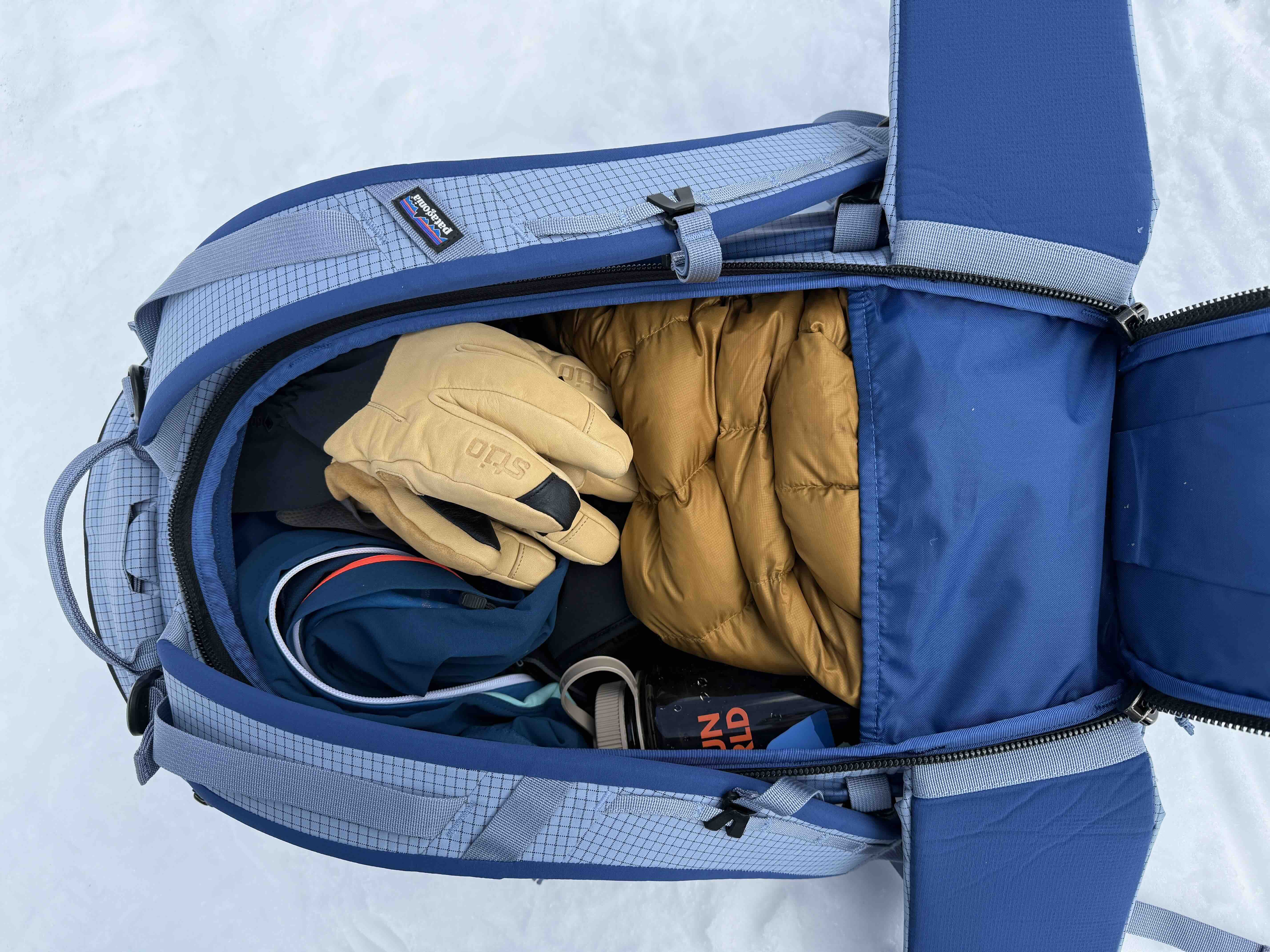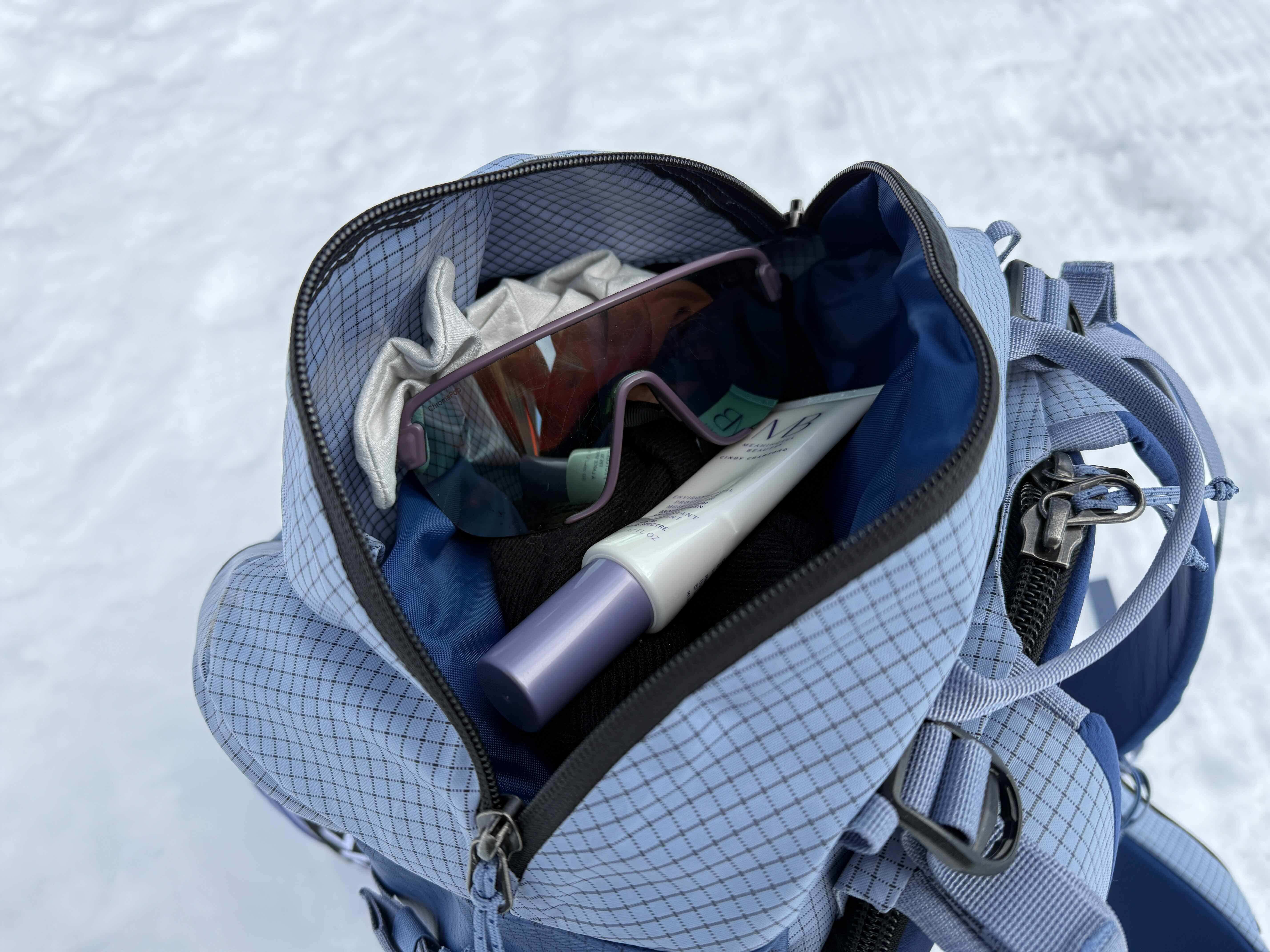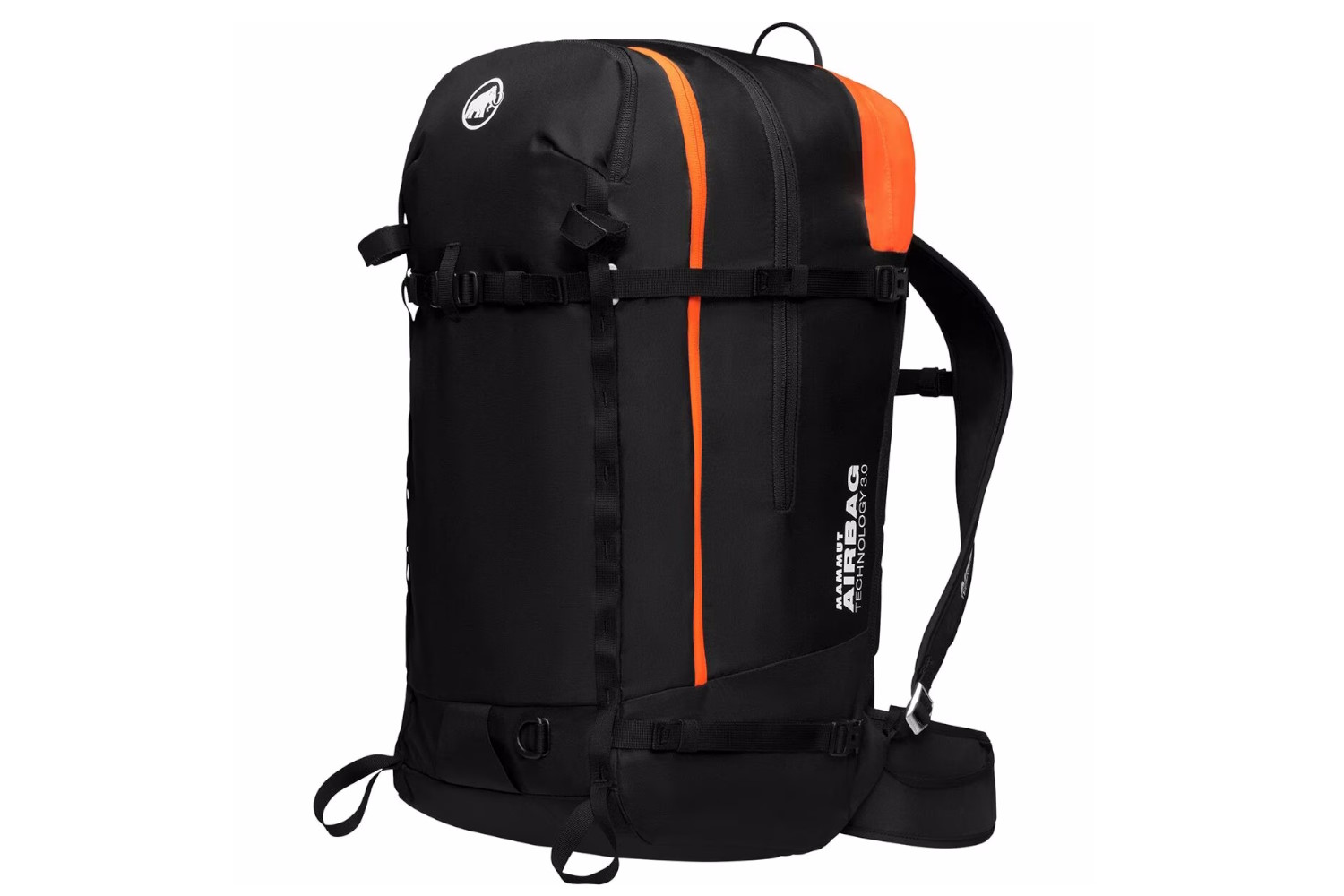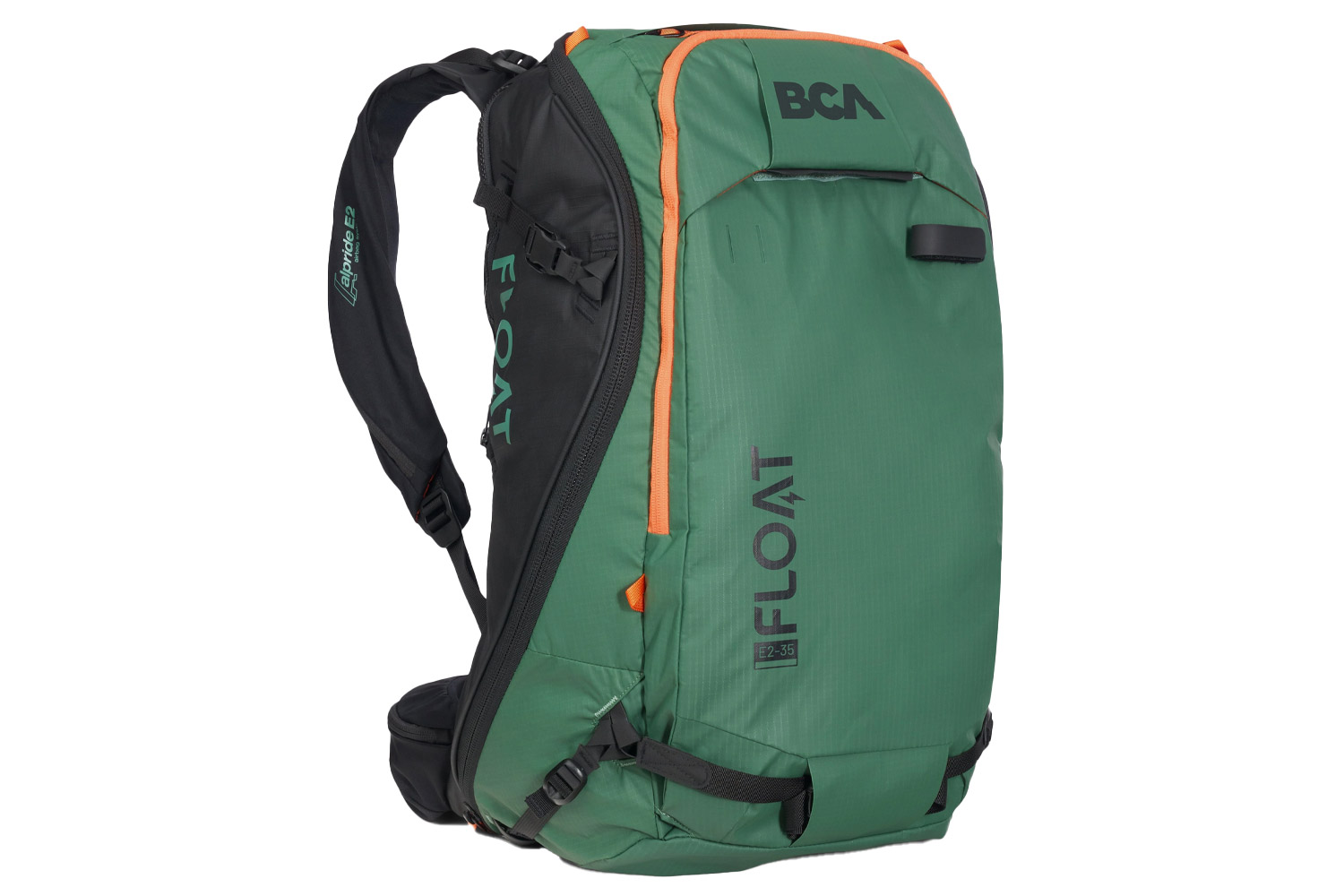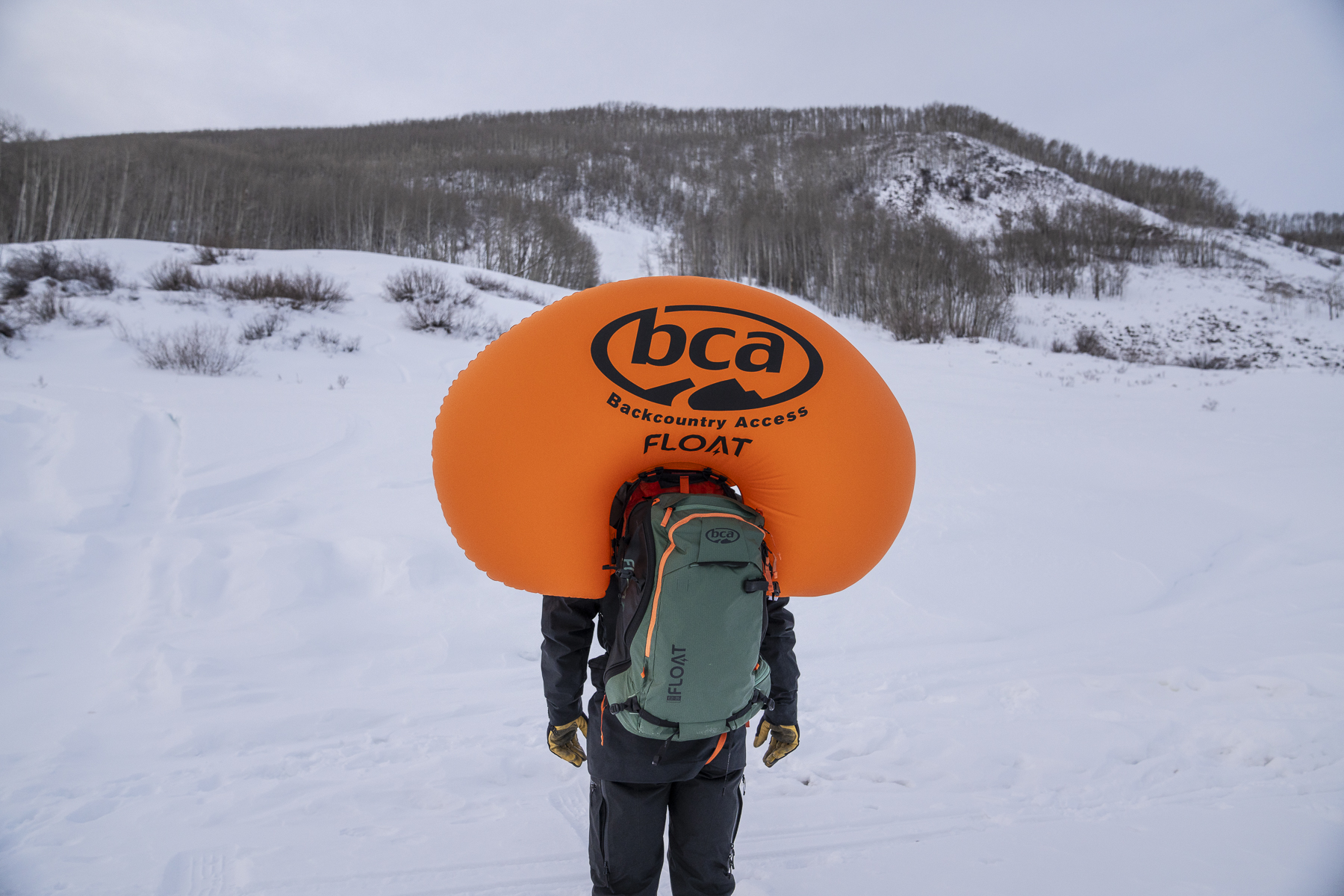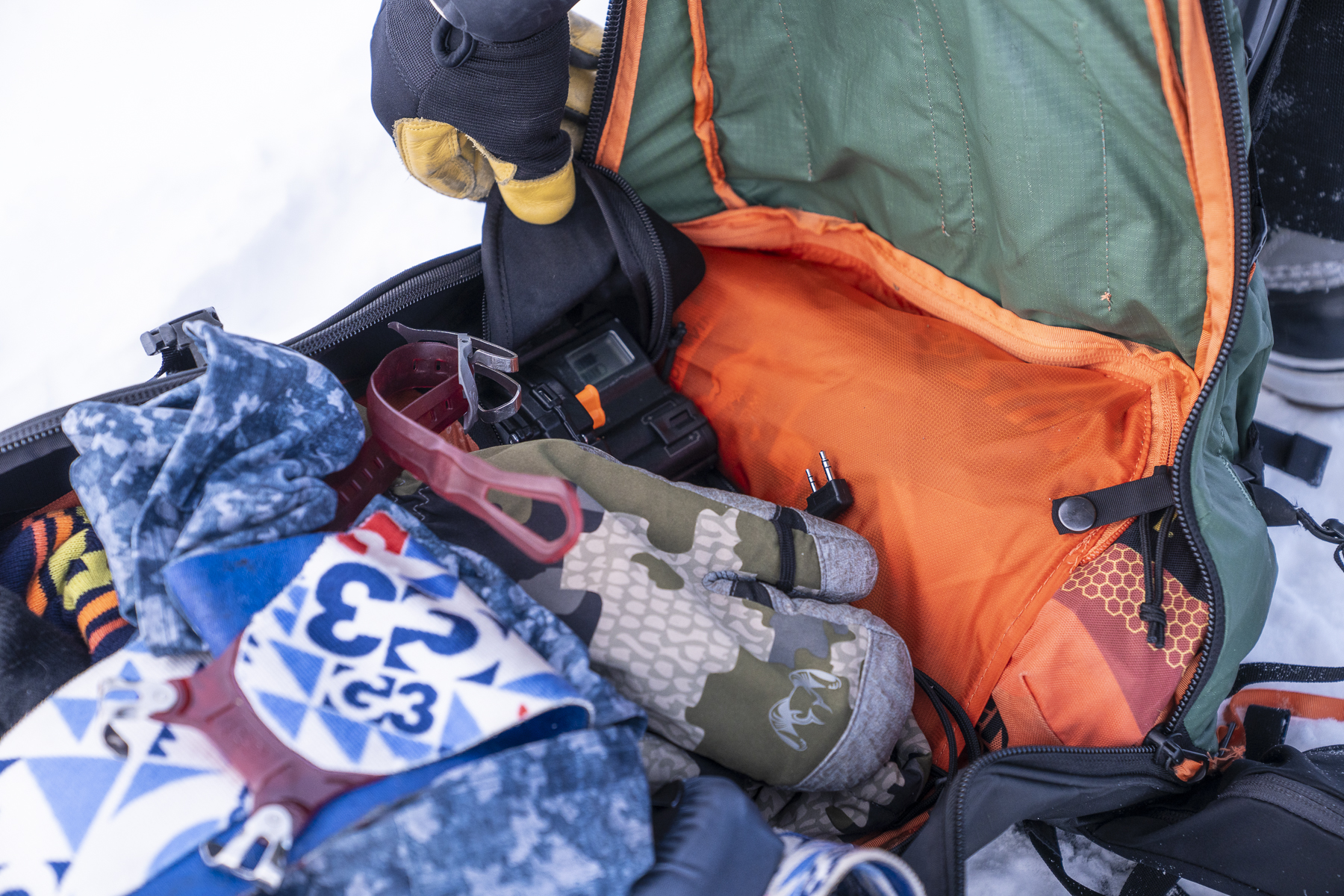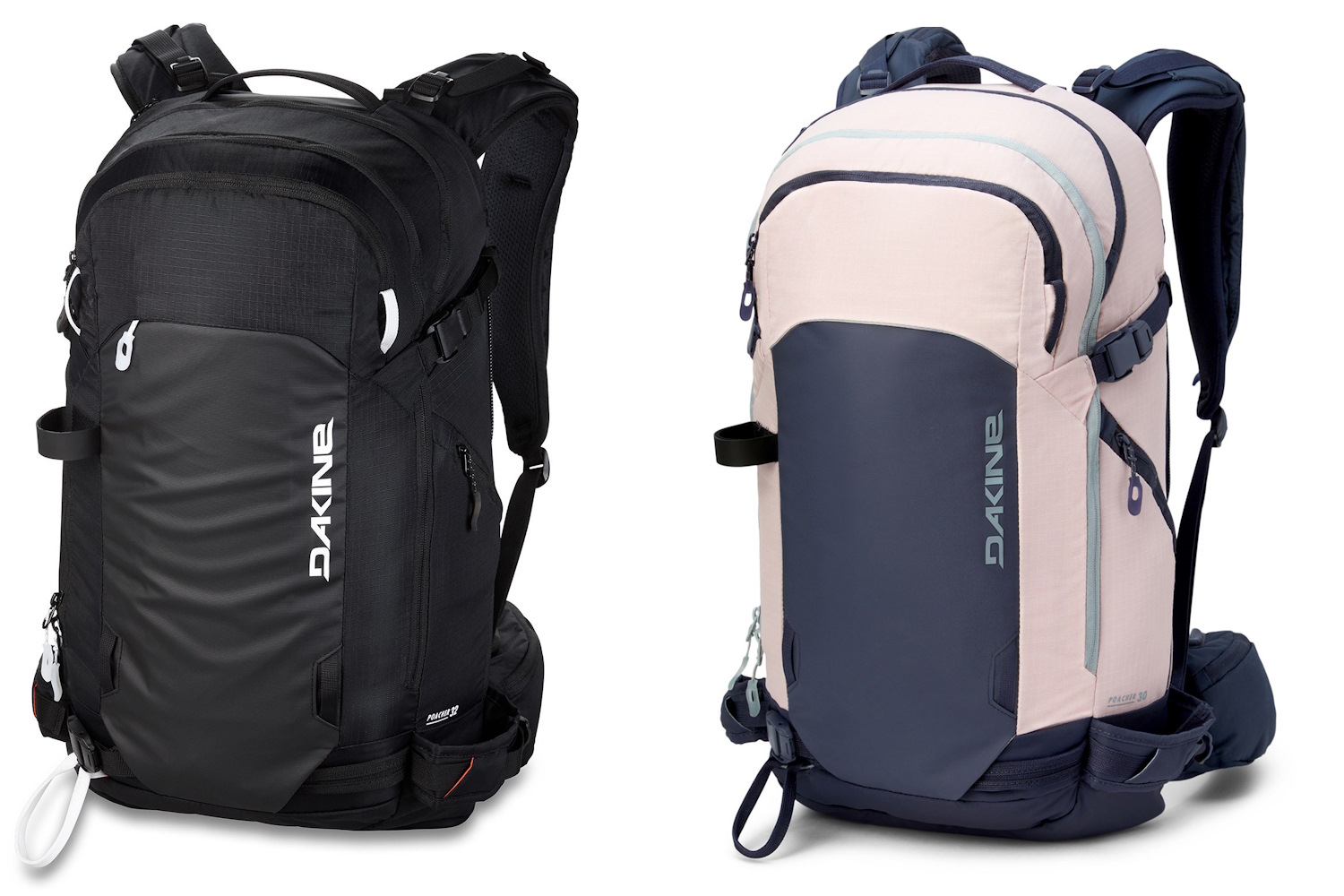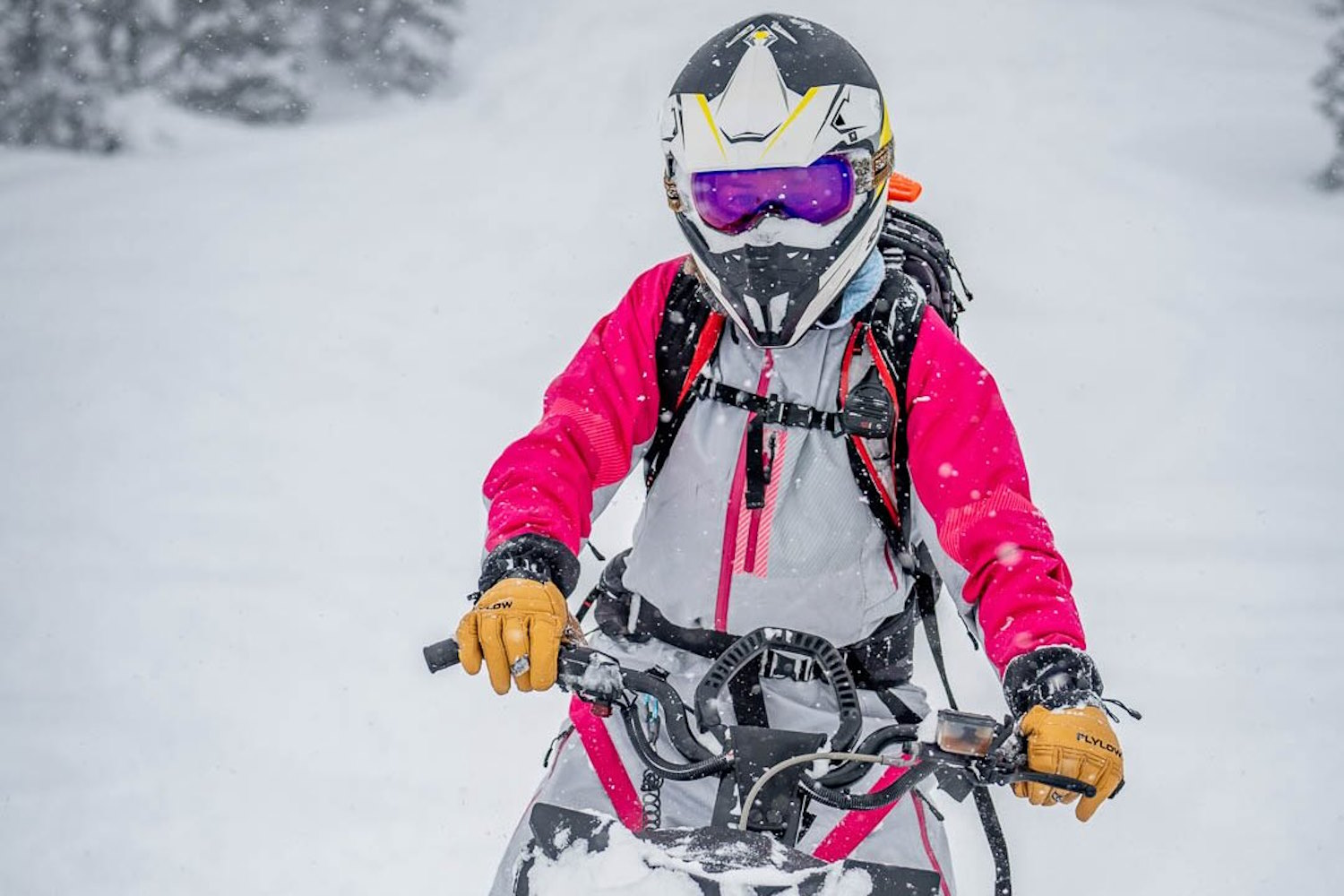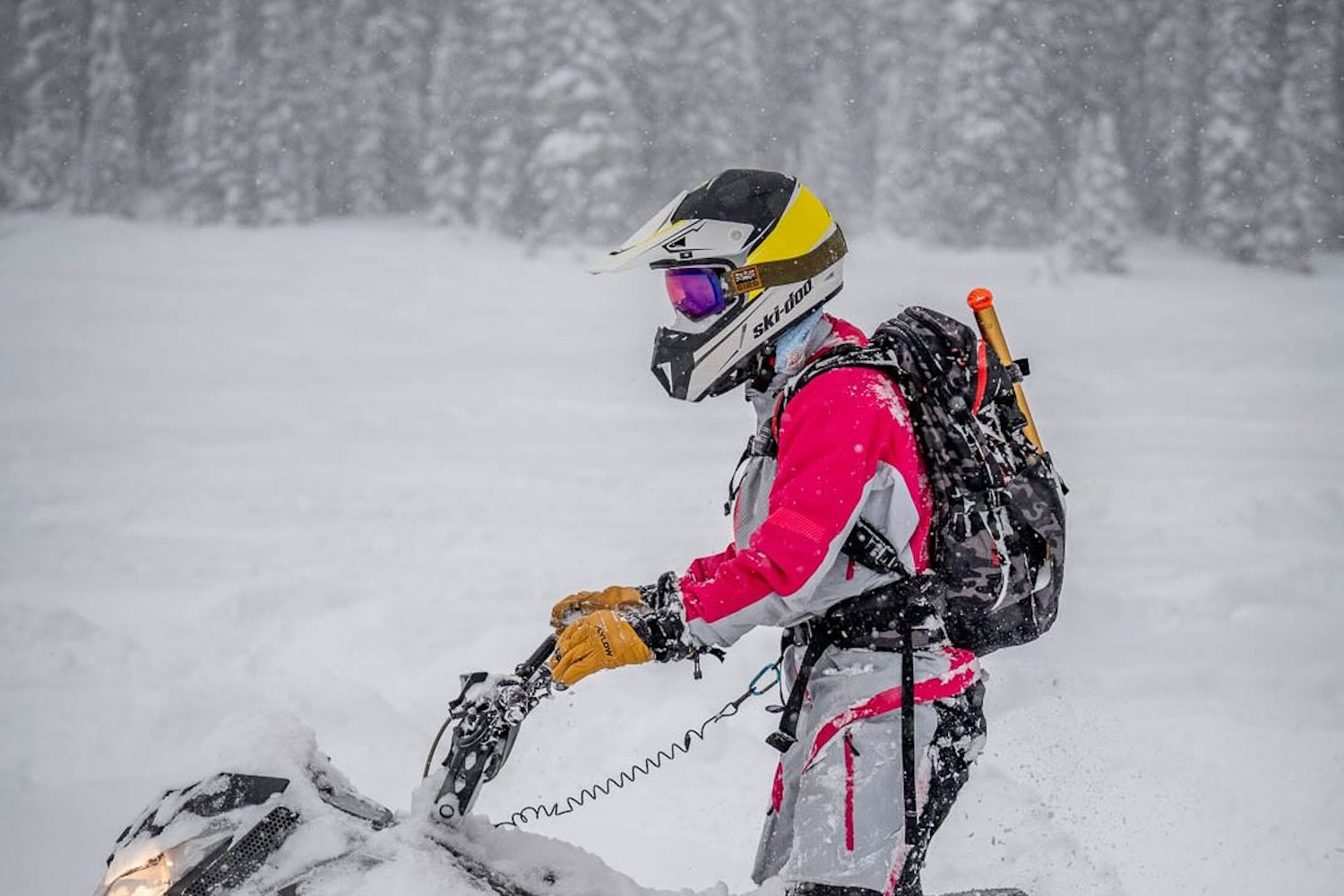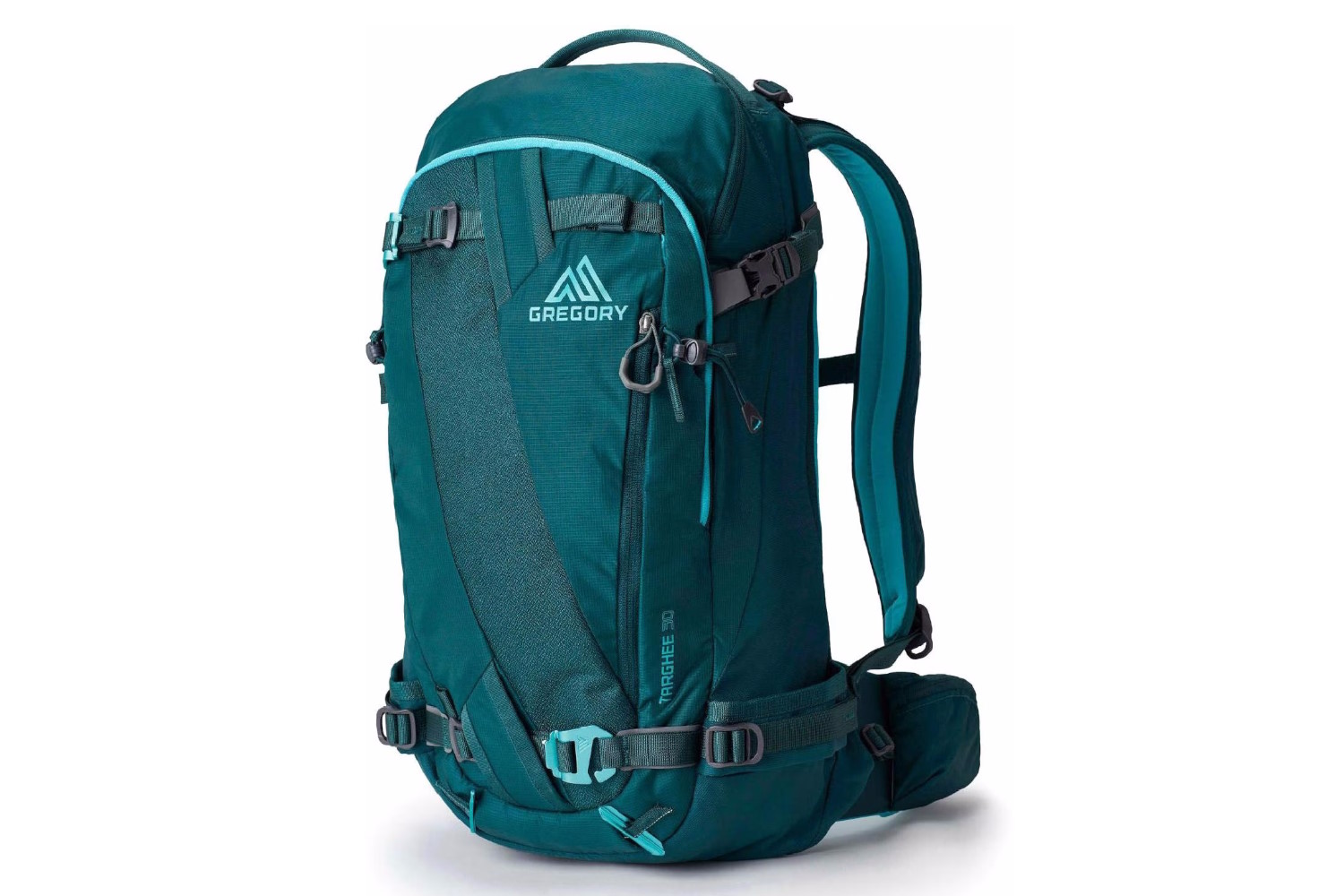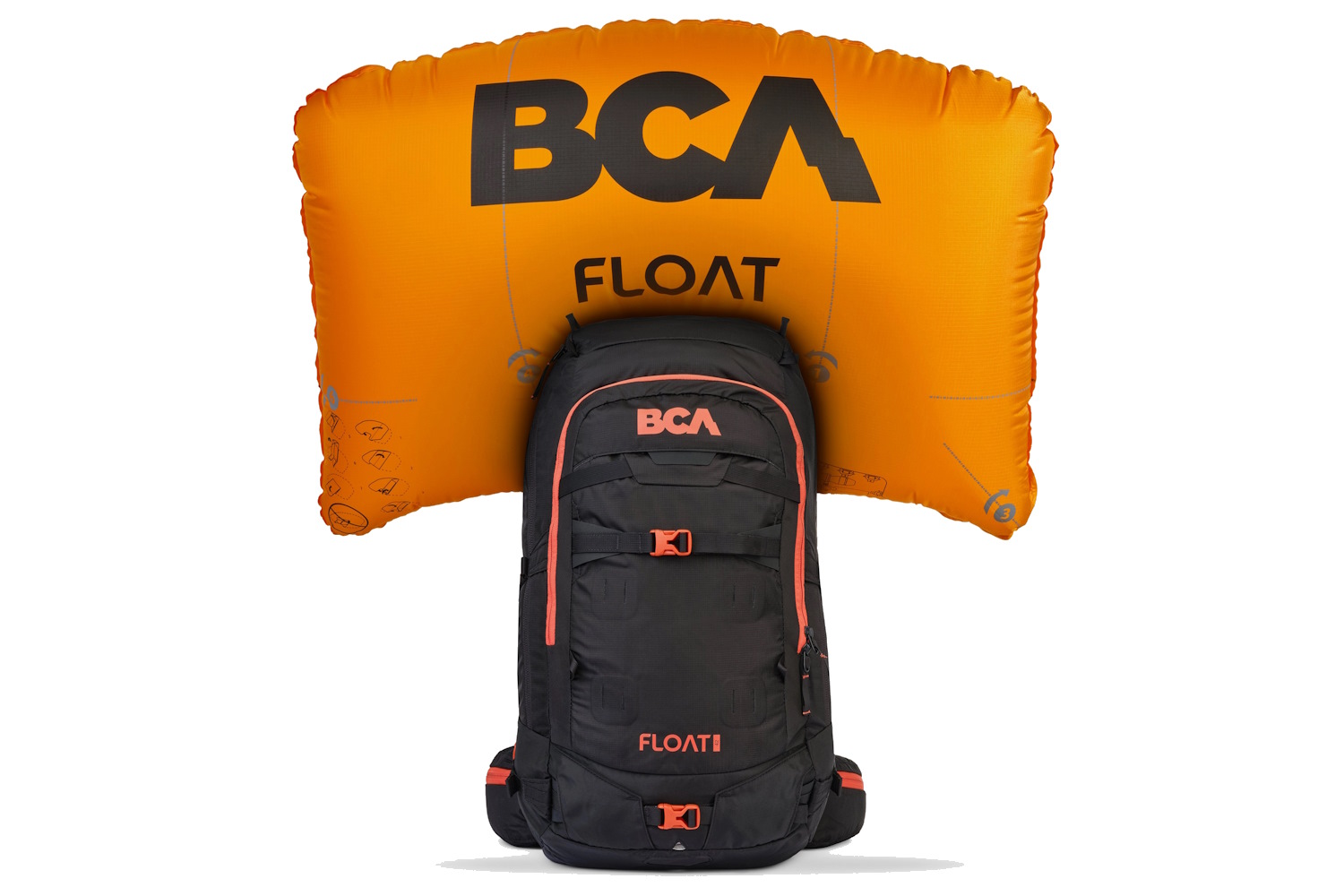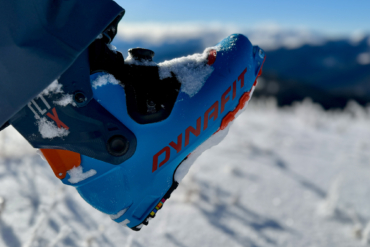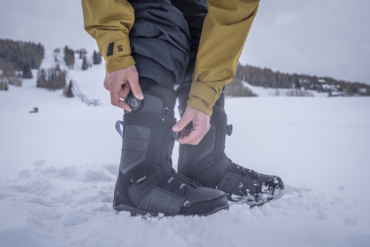Backcountry riders know how essential ski backpacks are for carrying avalanche rescue tools. Whether you’re a skier, splitboarder, snowmobiler, or a resort hound, you know the value of a well-made winter pack. Other times, these packs carry a few energy bars and a water bottle or an extra pair of mittens. Picking the right ski pack for your day on the slopes depends a lot on the mission at hand and whether or not you’re in avalanche terrain.
While most packs have a lot in common — namely, shoulder straps and a central zippered compartment — they differ wildly in size, weight, and how much they’ll comfortably carry. Packs these days are incredibly well-made. Materials are built to last, seams are heat-welded or bar-tacked, and buckles only break if they’re abused.
You’ll find moderate-volume packs with extremely durable construction and intelligent pocket designs like the BCA Stash 30. You’ll also come across higher-end, larger-volume packs with airbag compatibility, such as the Mammut Pro 45 Removable Airbag 3.0. Smaller day-use packs for lightning-fast missions or hydration at the ski area are on our list, too: the CamelBak SnoBlast 22 Hydration Pack and the Black Diamond Cirque 25 Pack.
Editor’s Note: We updated our Ski Backpacks guide on September 8, 2025, to include the field-tested and awarded The North Face Slackpack 2.0 Backpack, a compact 20L design, and the lightweight yet smartly spacious 38L Patagonia PowSlayer Pack.
The Best Ski Backpacks of 2025-2026
Most Comfortable Women's-Specific Ski Backpack
Deuter Freerider 28 SL Ski Tour Backpack
8.8/10 RatingBCA Stash 30
- Best use: Backcountry tours, ski, and splitboard mountaineering
- Weight: 3 lbs., 5 oz.
- Capacity: 30 L
- Carry: A-frame and diagonal ski (or splitboard ski) carry or vertical snowboard carry
Pros
- Excellent organization and comfort
- Stowable helmet sling
Cons
- Small goggle pocket
The North Face Slackpack 2.0 Backpack
- Best use: Cat skiing, hike-to in-bounds terrain, sidecountry
- Weight: 2 lbs., 1.2 oz.
- Capacity: 20 L
- Carry: Diagonal ski carry, vertical or horizontal snowboard carry
Pros
- Lean and streamlined
- Fleece-lined goggle pocket and zippered mesh pocket
- Unique external glove-carry on left sleeve
- Large grab handle at top
Cons
- Basic hip belt is unpadded
- Volume and support is not a match for full-day tours
- No helmet-carry hammock
Patagonia PowSlayer Pack
- Best use: Backcountry tours, hike-to terrain
- Weight: 2 lbs., 9 oz.
- Capacity: 38 L
- Carry: A-frame, diagonal ski (or splitboard ski), or vertical snowboard carry
Pros
- Back panel easily sheds snow
- Two roomy hip belt pockets
- Top or front helmet carry
- Lightweight yet roomy
Cons
- Limited to back panel access for the primary compartment
- Back panel zippers and pulls stiffen and get sluggish in frigid, snowy conditions
- Adjustable chest straps securely attach to a daisy chain but don't easily slide on-the-go
Deuter Freerider 28 SL Ski Tour Backpack
- Best use: Backcountry tours
- Weight: 2 lbs., 3 oz.
- Capacity: 18 L ($145), 28 L, Pro 32 L+ ($190)
- Carry: Diagonal or A-frame carry for skis or splitboard skis and vertical option snowboard
Pros
- Adjustable sternum strap
- Load adjustment straps
- Ice axe attachment
Cons
- Only one hip belt pocket
- Helmet carry accessory is not included or directly integrated in the 28L or 18L pack
- No enclosed shoulder strap protection for hydration hose or radio line
Mammut Pro 45 Removable Airbag 3.0
- Best Use: Big and remote tours, overnighters
- Weight: 3.6 lbs. without airbag; 5.8 lbs. with airbag
- Capacity: 45L
- Carry: Diagonal, front snowboard carry, A-frame carry (sans airbag and cartridge)
Pros
- High volume
- Airbag compatible
Cons
- Not the most comfortable lumbar support and shoulder straps
BCA Float E2-35 Avalanche Airbag
- Best use: Airbag, backcountry tours, overnight and hut trips, ski and splitboard mountaineering
- Weight: 6 lbs, 2.5 oz.
- Capacity: 31 L with airbag system; 35 L without airbag system
- Carry: A-Frame, diagonal, vertical snowboard carry
Pros
- Electric, re-deployable avalanche airbag system
- AA battery backup for additional deployments
- TSA approved for easy air travel
- Stash pocket for on-the-go access
Cons
- Snowboard carry could be better
- Helmet carry wont work with snowboard carry
- Pricier than canister airbag packs
Eddie Bauer Alpine Sisu 50
- Best use: Backcountry tours, ski and splitboard mountaineering
- Weight: 3 lbs., 14 oz.
- Capacity: 50 L
- Carry: A-frame for skis or splitboard skis
Pros
- Roomy snow safety compartment
- Exterior zip pocket for skins
- Extendable top makes the pack adaptable
- Full back zipper access
Cons
- Lots of straps make the exterior a bit fussy
- No hip belt pocket to tote cellphone
- Only one size available
Other Ski Backpacks Carrying Our Essentials
- Best use: Full days backcountry splitboarding or skiing
- Weight: 3 lbs., 1.9 oz.
- Capacity: 30 L, 32 L
- Carry: A-frame or diagonal ski or split-ski carry, front snowboard carry
Pros
- Rescue whistle integrated on chest strap
- Splitboard specific exterior straps that hold 3-piece poles
- Three options for snowboard and splitboard-ski carry
- Oversized fleece-lined goggle pocket
Cons
- Would like dual access to the primary compartment
- R.A.S. available on smaller volume but not larger volume
- Best use: Backcountry sled-skiing
- Weight: 7 lbs., 4.8 oz
- Capacity: 15 L (S), 20 L (M/L and XL/XXL)
- Carry: External shovel carry
Pros
- Full stability with no pack-swing
- Full front, side, and back protection against rocks, handlebars, and trees
- Integrated airbag for additional safety
Cons
- Premium cost
- Stuffing the pack too full can lead to the airbag compartment zipper prying open
- Takes an extra minute to get suited up compared to a regular pack
- Best use: Resort days, hike-to terrain with skis
- Weight: 2 lbs., 4 oz.
- Capacity: 22 L
- Carry: Skis
Pros
- Quick-release loops at the bottom of each shoulder strap let you swiftly loosen the pack and swing it around while getting on the lift
- Insulated hydration sleeve and designated reservoir compartment
Cons
- No snowboard carry
- Helmet loops keep helmet loose on back of pack
- Best Use: Backcountry days and quick laps at the resort
- Weight: 3.18 lbs.
- Capacity: 24 L, 30 L, 45 L
- Carry: Diagonal, A-frame, front snowboard carry
Pros
- Extremely comfortable lumbar support
- Super deep, spacious top pocket – a well-integrated backpack brain
- Great ski and snowboard carry
- Both top and back panel access
Cons
- The lock levers on the two upper side buckles are annoying and not durable
- Slightly heavy for its size
- Best use: Backcountry and side-country skiing, splitboarding, and snowboarding
- Weight: 3 lbs., 3.2 oz.
- Capacity: 30 L
- Carry: Diagonal and A-frame ski carry, vertical snowboard carry
Pros
- Premium lumbar support
- Bluesign approved recycled materials
- PFC-free DWR coating to shed moisture
- Sternum strap has integrated safety whistle
Cons
- It’d be even better if we could access the primary compartment through the front in addition to the back panel
- Goggle stash pocket isn’t fleece-lined
- Best use: Airbag, backcountry tours, overnight and hut trips, ski and splitboard mountaineering
- Weight: 7.1 lbs. (with full cylinder)
- Capacity: 12 L, 22 L, 32 L, 42 L
- Carry: Diagonal carry for skis or splitboard skis, vertical carry for snowboard
Pros
- Height-adjustable hip belt
- Removable helmet carry
- Internal and external ice axe carry options
Cons
- A bigger investment
- Additional weight with the airbag setup
- Canister sold separately
- Best use: Ski mountaineering, backcountry hut trips
- Weight: 2 lbs., 8.7 oz.
- Capacity: 40 L (size S/M), 42 L (size M/L)
- Carry: A-frame or diagonal ski carry (or split-ski carry)
Pros
- Super lightweight
- Roomy, convenient side pocket for skins or other goods
Cons
- No back panel entry so pack access is limited while loaded in the A-frame carry
- Detachable helmet carry poses the risk of blowing away or getting misplaced
- Straps on front are not secure and we lost our ski crampons on a snowmobile approach
- Best use: Ski and splitboard mountaineering
- Weight: 1 lb.
- Capacity: 25 L, 35 L, 50 L
- Carry: Tuck-away diagonal ski carry (or split skis) and A-frame carry
Pros
- Extremely lightweight
- Thoughtful design for organization
Cons
- Only provides top access to goods
- Not much padding or support for heavy loads
Ski Backpack Comparison Chart
Scroll right to view all of the columns: Price, Best Use, Weight, Capacity, Carry.
| Ski Backpack | Price | Best Use | Weight | Capacity | Carry |
| BCA Stash 30 | $180 | Backcountry tours, ski and splitboard mountaineering | 3 lbs., 5 oz. | 30 L | A-frame, diagonal ski (or splitboard ski) carry, vertical snowboard carry |
| The North Face Slackpack 2.0 | $99 | Cat skiing, hike-to in-bounds terrain, sidecountry | 2 lbs., 1.2 oz. | 20 L | Diagonal ski carry, vertical or horizontal snowboard carry |
| Patagonia PowSlayer Pack | $249 | Backcountry tours, hike-to terrain | 2 lbs., 9 oz | 38 L | A-frame, diagonal ski (or splitboard ski), or vertical snowboard carry |
| Deuter Freerider 28 SL Snow Pack | $165 | Backcountry tours | 2 lbs., 3 oz. | 18 L, 28 L, Pro 32 L+ | Diagonal, A-frame carry for skis, splitboard skis, vertical option snowboard |
| Mammut Pro 45 Removable Airbag 3.0 | $900 | Big and remote tours, overnighters | 3.6 lbs. without airbag; 5.8 lbs. with airbag | 45 L | Diagonal, front snowboard carry, A-frame carry |
| BCA Float E2-35 Avalanche Airbag | $1,300 | Airbag, backcountry tours, overnight and hut trips, ski and splitboard mountaineering | 6 lbs., 2.5 oz. | 31 L, 35 L | A-Frame, diagonal, vertical snowboard carry |
| Eddie Bauer Alpine Sisu 50 | $299 | Backcountry tours, ski, splitboard mountaineering | 3 lbs., 14 oz. | 50 L | A-frame for skis, splitboard skis |
| Dakine Women’s Poacher 30L & Dakine Men’s Poacher 32 L | $215 | Full days backcountry splitboarding or skiing | 3 lbs., 14.4 oz. | 32 L, 30 L | A-frame or diagonal ski or split-ski carry, front snowboard carry |
| BCA Float MtnPro Vest Avalanche Airbag 2.0 | $800 | Backcountry sled-skiing | 7 lbs., 4.8 oz. | 15 L, 20 L | External shovel carry |
| CamelBak SnoBlast 22 Hydration Pack | $120 | Resort days, hike-to terrain with skis | 2 lbs., 4 oz. | 22 L | Skis |
| Gregory Women’s Targhee 30 , Gregory Targhee 45 | $200-220 | Backcountry days, quick resort laps, guiding, hut trips | 3.18 lbs. | 24 L, 30 L, 45 L | Diagonal, A-frame, front snowboard carry |
| Osprey Kresta 30 & Osprey Kamber 30 | $210 | Backcountry and side-country skiing, splitboarding, and snowboarding | 3 lbs., 3.2 oz. | 30 L | Diagonal and A-frame ski carry, vertical snowboard carry |
| BCA Float 42 Avalanche Airbag | $750 | Airbag, backcountry tours, overnight, hut trips, ski, splitboard mountaineering | 7.1 lbs. | 12 L, 22 L, 32 L, 42 L | Diagonal carry for skis, splitboard skis, vertical carry for snowboard |
| Mountain Hardwear Snoskiwoski 40 | $220 | Ski mountaineering, backcountry hut trips | 2 lbs., 8.7 oz. | 40 L, 42 L | A-frame or diagonal ski carry |
| Black Diamond Cirque 25 Pack | $200 | Ski, splitboard mountaineering | 1 lb., 11 oz. | 30 L, 35 L, 45 L | Tuck-away diagonal ski carry (or split skis), A-frame carry |
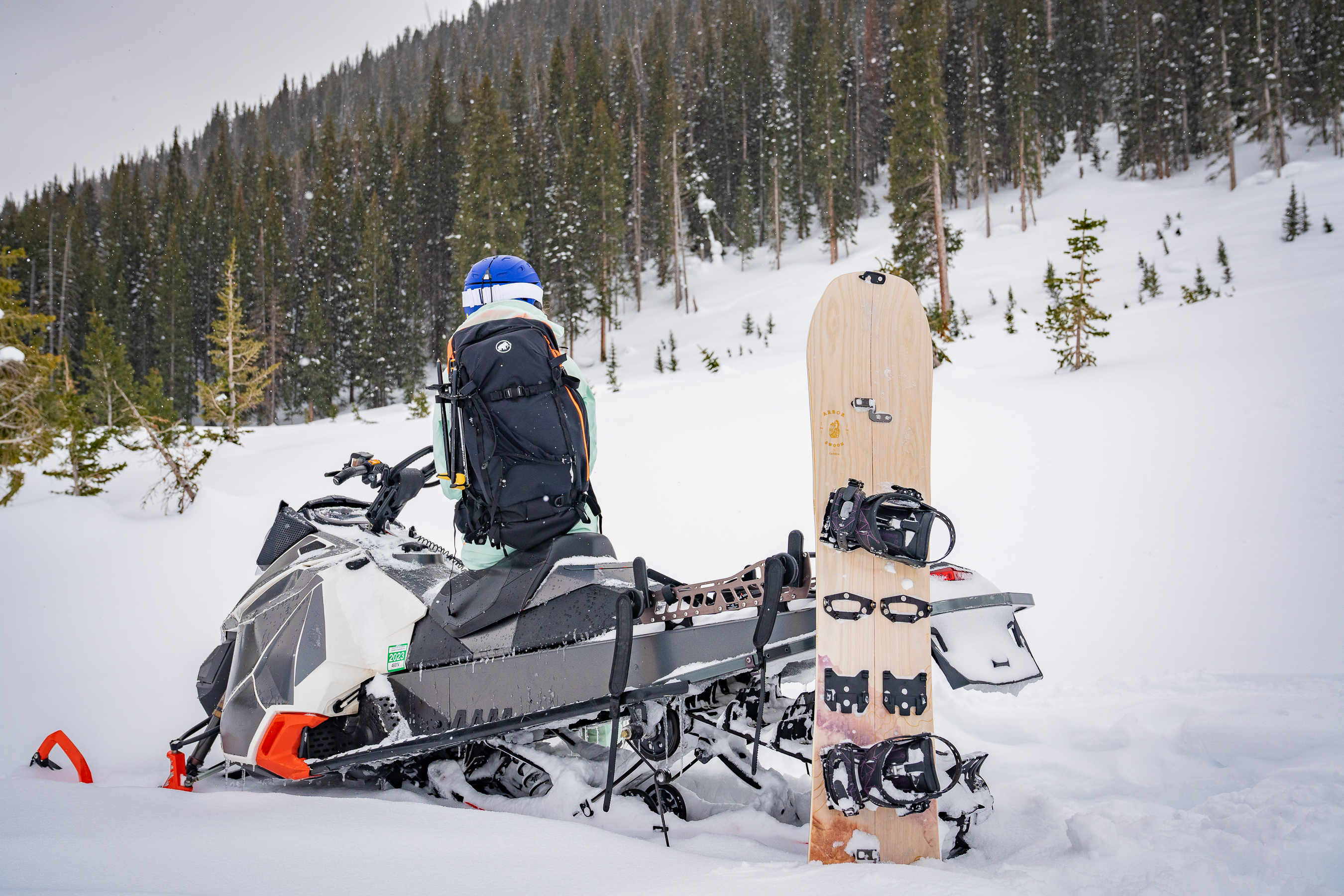
How We Tested Ski Packs
Our GearJunkie team includes backcountry skiers and splitboarders who explore backcountry zones and inbounds ski areas across the United States and overseas.
Our Expert Testers
Among our testers, Snowsports Senior Editor Morgan Tilton started alpine skiing in her backyard at Telluride Ski Resort at age 4, followed closely by snowboarding. In 2007, she completed her first AIARE 1 course. She’s thankful the industry now makes stellar splitboards, breaking the need to snowshoe with a solid board on her back. While Tilton manages our testers, she also gets field time.
So far in 2025, Tilton has tested ski backpacks for 106 hours, 241 miles, and 76,400 vertical feet moving through terrain. In 2024, she tested ski packs for 75 hours. In 2023, she put ski packs to the test for 84 hours on skis, splitboard, and snowmobile.
Our test team includes GearJunkie gear tester, reviewer and photographer Eric Phillips, a splitboarder, search-and-rescuer, and snowmobiler based in the Colorado Rockies. Since 2021, when this article was first published, backcountry skier Nancy Bouchard has also contributed. The guide has been updated eight times.
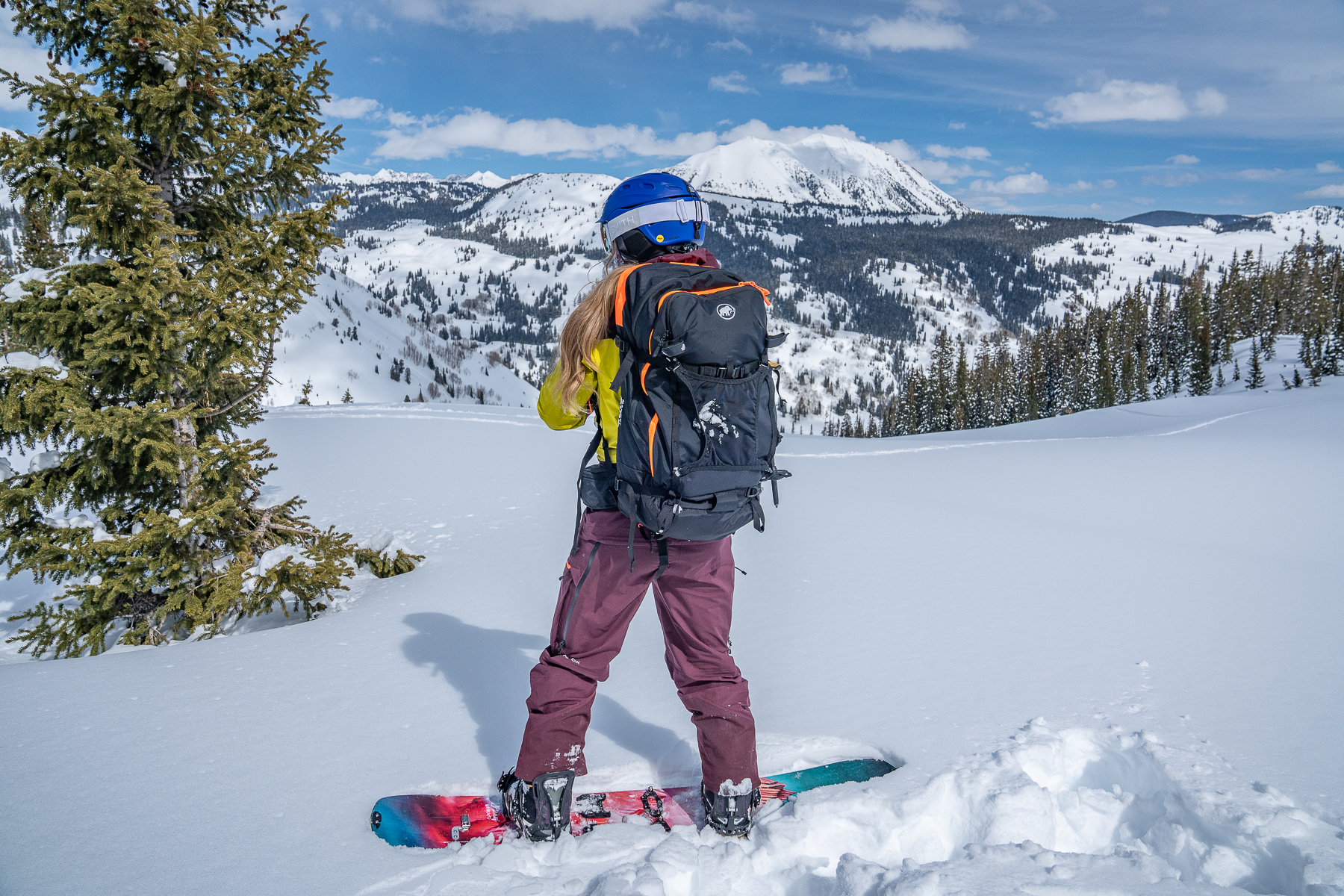
Our Testing Grounds
From the West to East Coast and around the Rocky Mountains, our testers pull on ski packs. They travel around the U.S. and overseas, venture into the backcountry, hike uphill at the resort, and use off-trail snowmobiles to play in and access out-there terrain.
The GearJunkie team meets for on-snow test weeks to grind out turns and swap notes, including two gatherings at Crested Butte Mountain Resort, which is known for its expert terrain.
Our Testing Process
Throughout our field tests and personal experience, we determine the best ski backpacks based on a variety of metrics, including fit adjustment, ergonomics, gear-carry options, zippers and straps, hydration compatibility, ease of use, organization from compartments to pockets, access, load placement, comfort, hip belt and shoulder strap design, performance, quality, durability, and value.
These excellent ski backpacks serve a range of athletes, applications, volume of gear, and budgets.
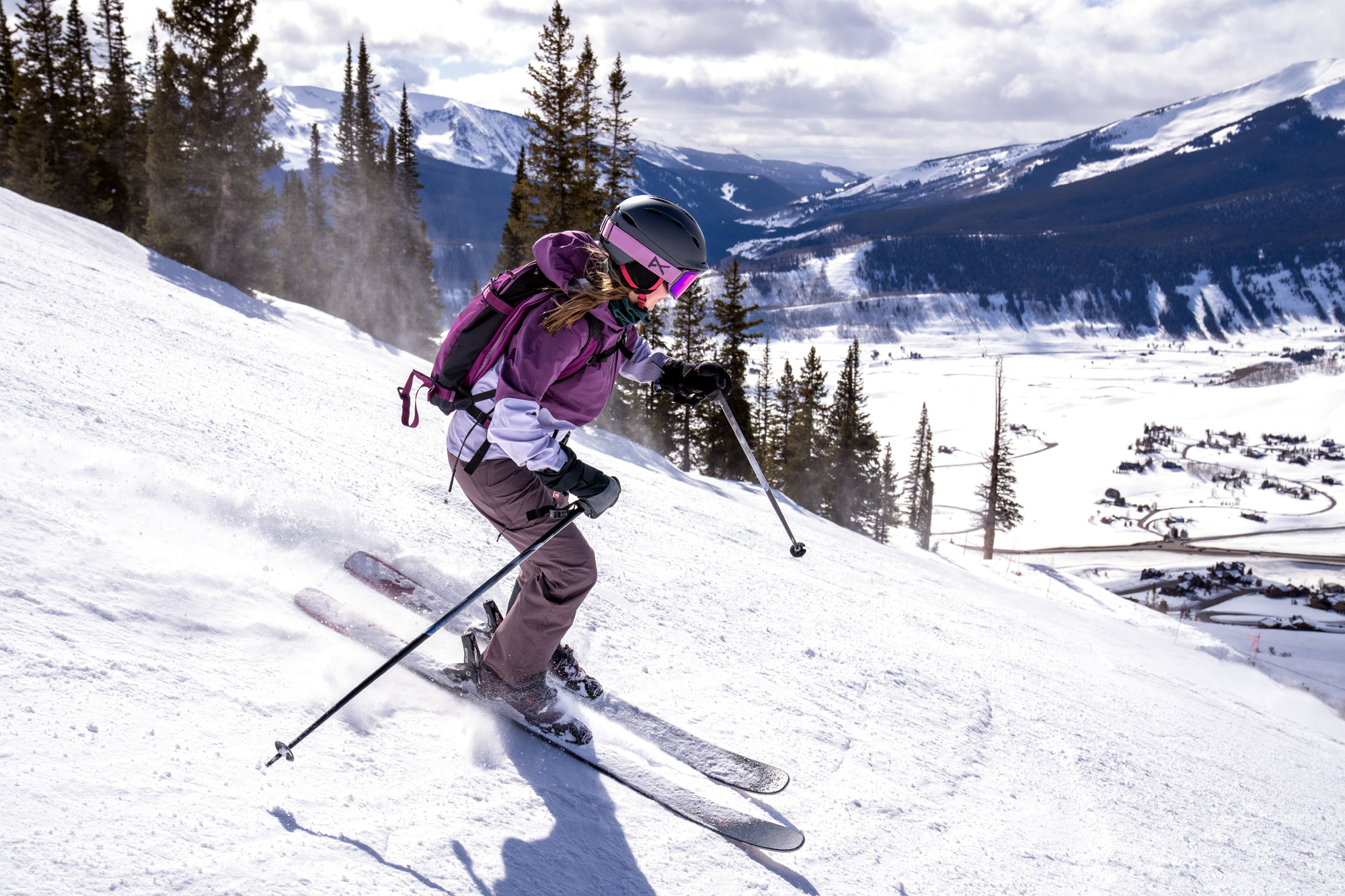
Buyer’s Guide: How to Choose the Best Ski Backpack
The trick to deciding what pack to buy is knowing what you’re going to use it for.
Do you want something small and compact you can carry for a quick uphill session at the ski hill after work? Or do you need a spacious, weight-bearing pack for an overnight hut trip or a weeklong summit snag with a remote basecamp?
Then, think about feature sets and overall capacity. Will you be carrying ice tools? A ski mountaineering axe? Crampons? Will you be on a splitboard or skis and what type? Will you be in-bounds only?
In your terrain, will you need avalanche safety equipment? Do you have room for all the necessary layers, enough food and water, and a tailored first-aid emergency kit? Do you need to carry a radio? Do you prefer to drink water through a bottle or hydration bladder?
These are a handful of the questions you should ask as you consider the best ski backpack for your needs.
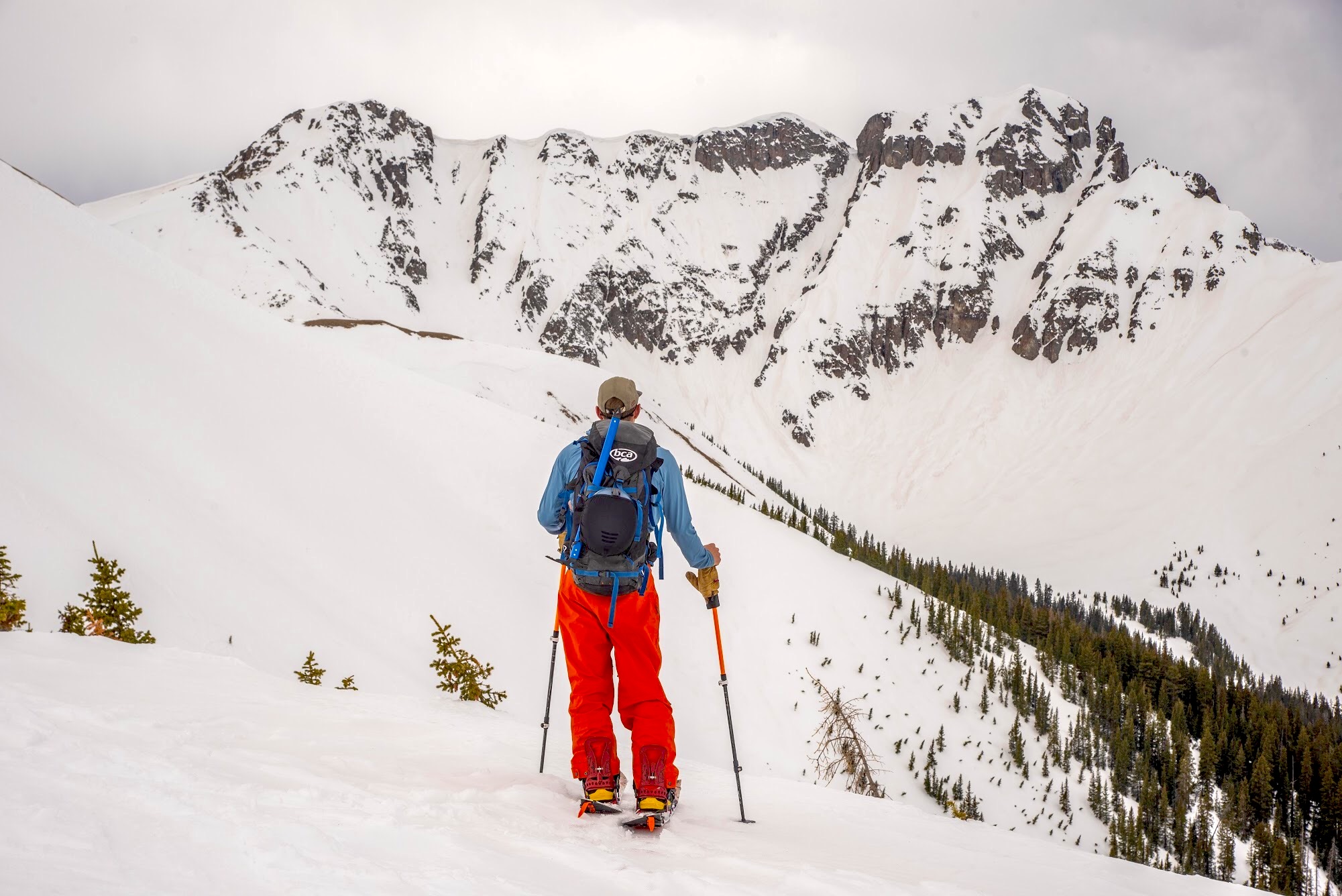
Types of Ski Backpacks
A wide variety of ski backpacks exist. Depending on your objectives and the terrain you’ll be in, you might want a pack that’s lightweight and simplified for in-bounds use or uphill sessions at a ski area. Or, you might need a streamlined, minimalist pack for fast and light training and skimo races.
If you’re heading into the backcountry, the ski or snowboard backpack you choose will have unique features. Namely, there will be a dedicated compartment with pockets for your avalanche safety gear: shovel and probe.
There will also be a helmet carry and radio integration via sleeves on the shoulder straps and, on some packs, an elastic loop on the chest strap to secure the mic.
Other backcountry packs offer greater capacity, enhanced back and shoulder support, and special organizational features for ski and splitboard mountaineering or multiday backcountry tours.

Size & Capacity
It’s important to match the pack size to your body shape and size. You don’t want a pack that’s too big or it will shift around. Nor will it be comfortable if it’s too snug.
Pack capacity is a personal choice, dependent on whether you go fast and light or you’re the type of person who wants or needs room for plenty of gear.
In general, sub-20 L packs are ideal for resort skiing and riding, uphilling, or skimo races. Some of these compact packs even have a ski and snowboard carry, which is a nice feature for hike-to in-bounds terrain.
A pack from 20 to 35 L that can haul more is ideal for side-country, backcountry, and gear-intensive trips. A few of the packs in that house include the 20-liter The North Face Slackpack 2.0.
Some pack designs in the 30 L to 35 L realm are designed to support ski and splitboard mountaineering expeditions like the BCA Stash 30.
Packs from 40 to 50 L are more stout for backcountry overnight missions and hut trips as well as mixed alpine and mountaineering ascents.
The leanest pack among our top picks is the 22 L CamelBak SnoBlast 22 Hydration Pack for hike-to terrain and lift days. The beefiest load-carrying pack is the Eddie Bauer Alpine Sisu 50, a 50 L animal for backcountry tours, mountaineering, overnighters, and hut trips.

Suspension & Carry Comfort
Suspension refers to the shoulder straps, hip belt, and frame sheet. Generally, the bigger the backpack, the more weight you can carry. And more weight requires a more sophisticated suspension system for comfortable carry.
Shoulder straps are generally padded to help cushion your shoulders from the weight. They also help disperse the weight from the pack.
New materials provide cushioning with less bulk. Most modern shoulder straps are a combination of dense foam and breathable mesh. The more weight a pack is designed to carry, the more robust the foam in the shoulder straps.
Hip belts are designed to help keep the pack from swinging around on your back. Packs that will carry 20 pounds or more need some sort of padded hip belt to help transfer weight to the hip bones.
Most hip belts are made of the same dense foam as shoulder straps. They’re built to snugly wrap around your iliac crest so the weight of your load is dispersed between your shoulders, back, and hips.
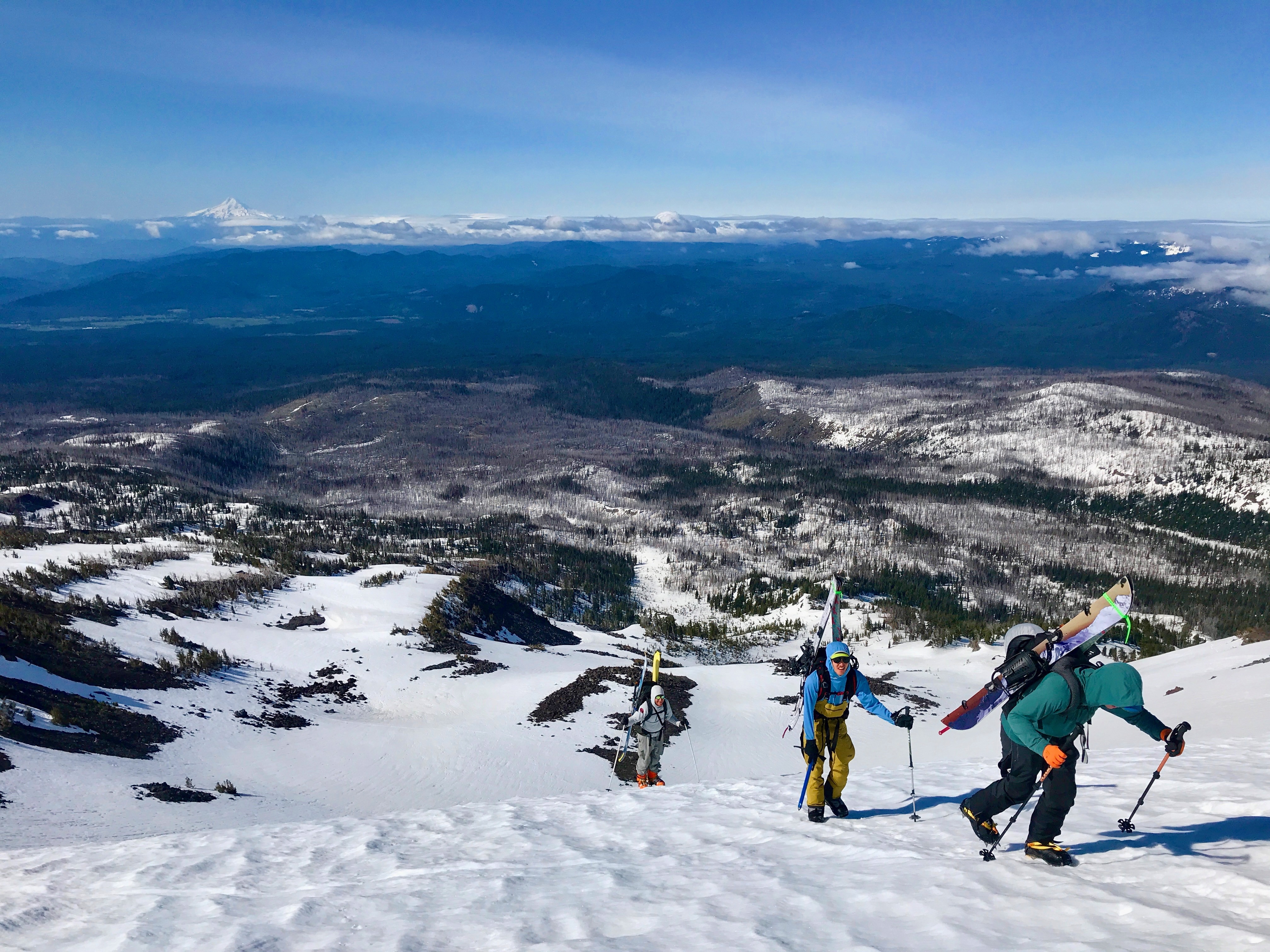
Torso Length
This is the distance (generally in inches) between the top of your shoulder to the top of your hip bone (iliac crest). Most packs fit torsos from about 16 to 20 inches.
If you have a very short or very tall back, you need to do some research into the manufacturers’ recommendations. Fortunately, most packs come in small/medium, large/XL, or small/medium/large sizing.
And with shoulder strap adjustments and load-lifter straps, you can generally get 2 to 4 inches of adjustment out of any pack. Plus, some manufacturers make packs with back panels that have adjustable lengths. In most cases, this is done by moving the shoulder straps up or down the back panel or moving the hip belt up.

Women’s-Specific Packs
Most of our top choices for ski pack designs are unisex or men’s, which can work fine for many riders and skiers regardless of gender. That said, everyone’s body is unique. Some women swear by women’s-specific packs. If you generally have a smaller frame, consider checking out a women’s-specific ski pack.
Compared to men’s or unisex packs, a women’s pack is constructed based on the average size of female bodies. The back length is shorter, and the carrying system — the hip belt and shoulder straps — hugs a narrower body figure. The hip belt is also made in a conical shape, which sits more comfortably on the hips.

Materials
Modern materials are unbelievably tough. It’s really difficult to wear a hole in a pack when it’s used correctly.
Abrasion is most likely to occur on the bottom of a pack. This is more common in packs hauling heavy loads of solid gear but naturally happens from setting the pack down on various terrain from rocks to ice or snow.
Packs designed for carrying ice-climbing equipment will generally have a padded bottom. This keeps sharp objects from poking through the bottom of the pack when you set it on a hard, rocky surface.
These specialty packs often use durable material in places where you attach an axe or crampons. Ski packs also have reinforced attachment points so sharp ski edges don’t cut into the pack.
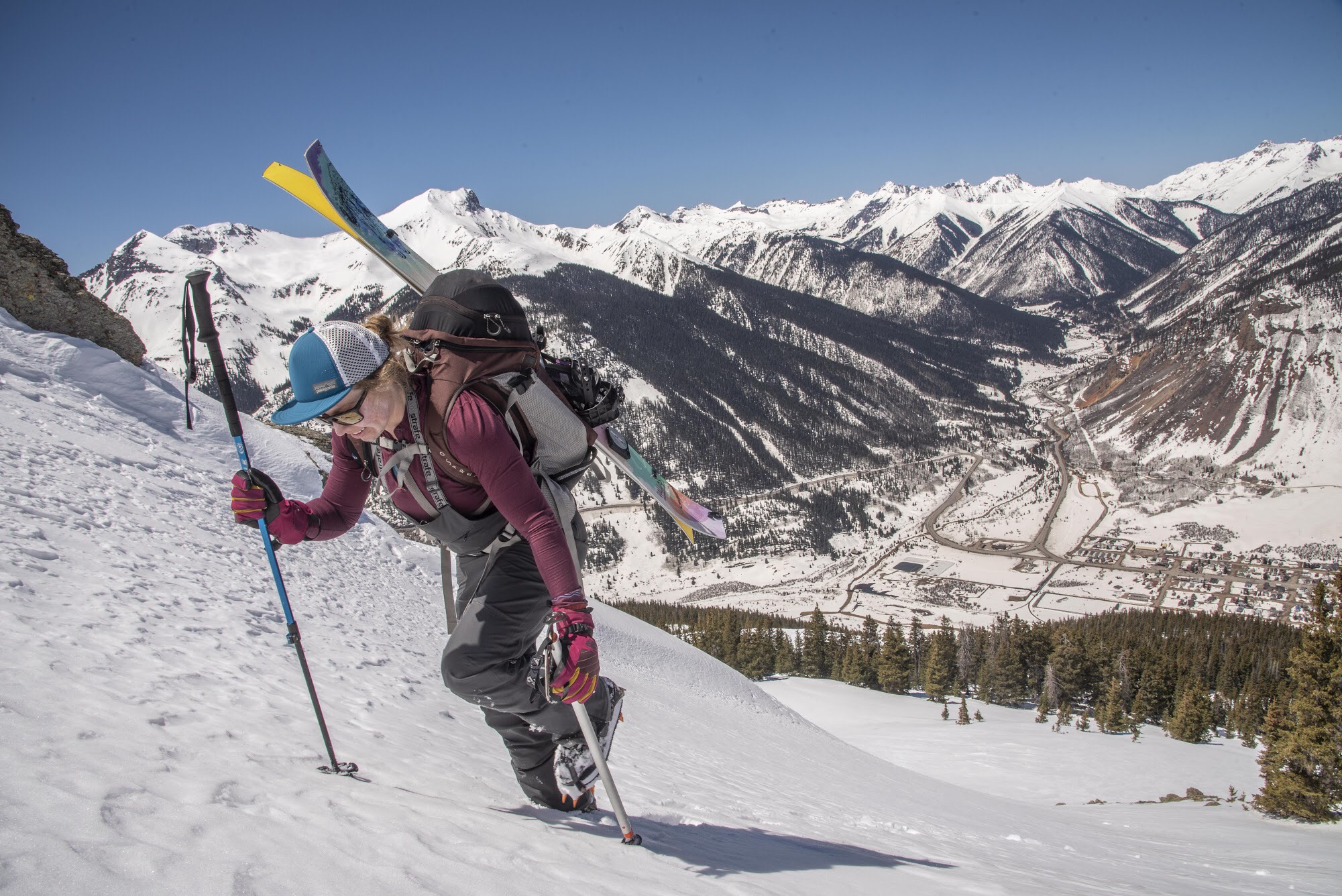
Organization
A major differentiator between ski pack styles is whether or not there’s a designated compartment for avalanche safety equipment — the shovel and probe. That design component is essential for backcountry and side-country recreationists because efficiency and organization are critical and life-saving.
Hydration Compatible
Many ski and snowboard packs have an internal sleeve for a hydration bladder and a sleeve to route the hose but not all sleeves are insulated. Beware — the water in your hose can freeze. To be proactive, you can blow the water back through the hose after each sip, but it can help to get a proper pack, too.
Pockets
Pockets add weight but are nice to keep everything in place. Efficiency is key when we are playing outdoors in cold, gusty, snowy elements.
We appreciate at least one spacious hip belt pocket if not two. These are handy if you want to keep snacks, sunscreen stick or sunscreen chapstick, slope angle reader, straps, or glove liners handy. Most packs for backcountry or front-country use have a softly lined goggle pocket and ski helmet carry, too.
Packs with one or two oblong pockets toward the top-front of the pack offer an easy-to-access placement for quickly grabbing items like a goggle lens, sunglasses, snack, ice scraper, rub-on skin wax, compact phone, or satellite communication device. Pockets that are buried deep inside the primary compartment are not ideal, because we typically need to dig through a pile of items to reach what we’ve stashed.
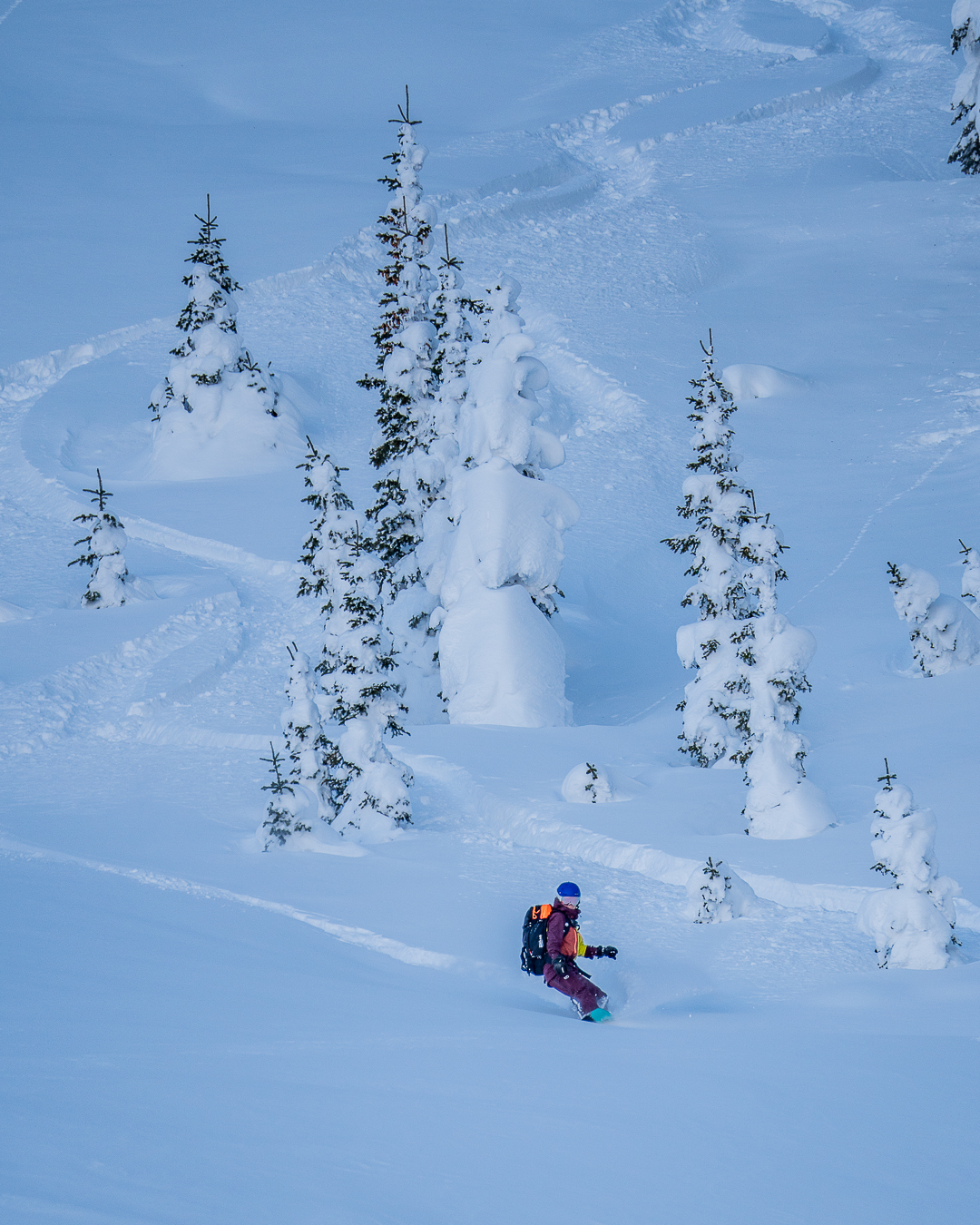


Ski & Snowboard Carry
Many ski backpacks have a ski-carry system — which can be used for skis or splitboard skis — and potentially one for snowboard carry, too.
Generally, backcountry skis — or a splitboard — can be attached to a ski pack via an A-frame setup, which many travelers feel is well-balanced. The caveat? An a-frame carry cannot be used with packs that are set up for an airbag to deploy. The other ski option carry is diagonal. Some pack designs feature straps for both of these arrangements. Other packs also provide a solid snowboard carry that is either vertical or horizontal.
Most of the time, how you carry your skis, split skis, or snowboard is a personal preference, but terrain management can also influence your choice, especially for split boarders. For instance, if you’re bootpacking a backcountry ridge or a short hike-to at the resort, you might not prefer a vertical snowboard carry if the tail is digging into your calves between steps.
However, if you are bootpacking a steep slope that will not top out with enough space to transition from split to solid or rappelling into the start of the descent, you might need to strap your assembled solid splitboard to the back of your pack.
You’ll want to be sure to practice clipping your skis, split skis, or snowboard onto your bag before you head to the backcountry to make sure you know how the strap arrangement functions. Be sure to pull on your pack to make sure your gear isn’t smacking the back of your calves or head.

Compartment Access
Snowsport packs often have back-panel access via a U-shaped zipper that lets you fold back the entire back panel like a clamshell. This method of entry is handy if you’re going to throw your pack down in the snow when you open it up. This way, your shoulder straps and back panel stand a better chance of staying dry and not soaking up water.
This design is also a convenient way to access gear that’s sitting in a certain quadrant of your pack without needing to unload all the goods into the snow or wind.
Some packs have front access through a large U-shaped zipper. Other designs blend the two entries with both a front and back-panel entry, which is super helpful. A handful of designs are top-loaders or have a roll-top closure.

Extra Ski Pack Features
Additional pack details range from a helmet carry system — usually a pouch or pocket that’s removable, stashable, or compressible — to a hydration sleeve for a bladder and an arm sleeve to protect the hose.
Compression straps are nice for hugging a load and making it more streamlined. Load-lift straps are key for adjusting how the pack sits on your shoulders and back, a fit that changes throughout the day due to adding or pulling out gear from inside the pack.
Some packs also have external and internal gear carriers — that are fixed, removable, or adaptable — for ice tools, an ice axe, poles, crampons, or a rope.
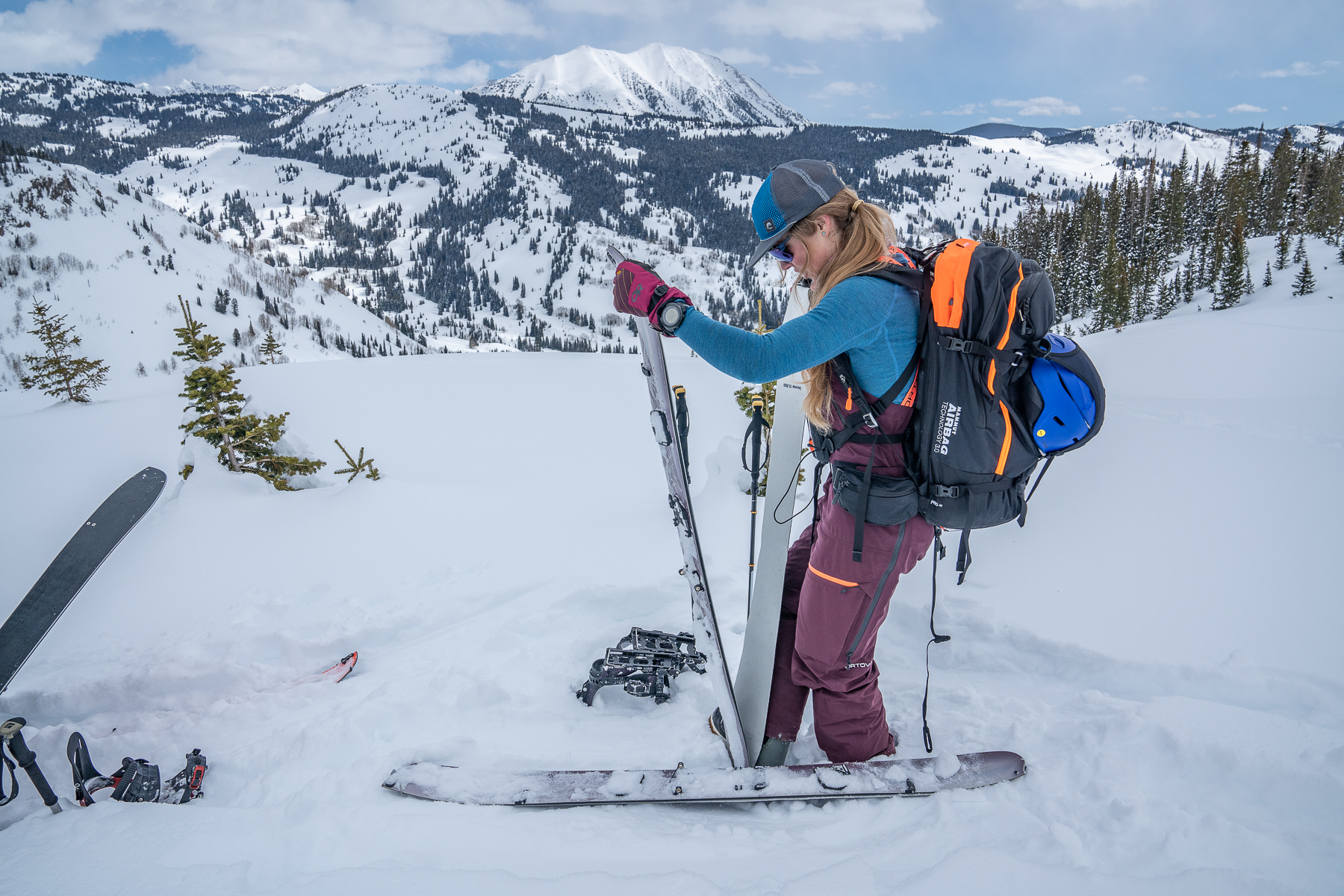
Price & Value
Ski packs have a huge price range from $120 to $900, and the investment is worthwhile no matter which end of the spectrum you’re on. Meaning that all of the packs on our list are of excellent quality and well-made. Here’s what you’re paying for on each end of the spectrum.
Budget
As far as price goes, the lowest-tier ski packs are designs that are lower volume with a few simple pockets and streamlined exterior straps or carry options. These designs are great for resort days, short backcountry outings — around a few hours — fast missions, or uphilling workouts.
For instance, the CamelBak SnoBlast 22 Hydration Pack ($120) is a solid choice for inbounds adventures when you find yourself in the back bowls, far away from concessions on a pow day. The Black Diamond Cirque 25 Pack ($200) is a straightforward, lean, tenacious mountaineering pack with an avalanche gear sleeve and not much else in the way of pockets.
Mid-Tier
Into the $200 lane, you’ll find more pockets, more padding, and more strategic features like an integrated safety whistle, helmet carry, and radio pocket. This collection includes some of the most comfortable, moderately-sized packs for half to full-day backcountry adventures — plus women’s specific hip belts and frames: the Osprey Kresta 30 & Osprey Kamber 30 ($210) and the Dakine Women’s Poacher 30 L & Dakine Men’s Poacher 32 L ($215).
On the upper level of this tier, you’ll find a super-strong high-volume pack like the Eddie Bauer Alpine Sisu 50 ($299), but it most likely won’t have avalanche bag integration. Tougher materials like Cordura are more commonly integrated into this mid to high-level price range.
Premium
It’s easy to see a steep hike in price for ski packs that add on avalanche bag integration and a large volume. Adding volume to a pack involves more materials but including avalanche airbag systems really drives the price up. Some of our favorite mega-space and safe packs include the Mammut Pro 45 Removable Airbag 3.0 ($900) and the BCA Float 42 Avalanche Airbag ($750).

Frequently Asked Questions
Generally, backpacks that are developed for ski and splitboard tours have a dedicated internal compartment for avalanche safety gear: the shovel and probe. (The beacon is worn on your person, not stored inside the pack.) These packs also have ski and splitboard or snowboard carry systems.
Ski touring packs usually have a hip belt to help support the load and prevent pack swing on the descent. Some hip belts are generously padded or even have zipper-enclosed pockets, while other designs are slim to help trim ounces.
Each pack has its own organizational features, including a potential hydration sleeve, radio integration, and lined goggle pocket plus various internal and external pockets for stashing items. Most conventional packs have some kind of helmet carry system that’s removable or stashable.
Some packs are larger and more robust than others in order to support a heavier load while touring for a day or more. Technical ski touring bags are outfitted with features to carry safety equipment from crampons to an ice axe or tools.
For resort riding, it’s certainly not a requirement. But it can be convenient to have for carrying extra snacks or a lunch, water, extra layers, gloves, an additional goggles lens in case the light conditions change, or a camera.
On the other hand, if you’re skiing in the backcountry, it’s an absolute must-have. You’ll need a backpack to carry avalanche safety gear, including your shovel and probe as well as a radio, satellite communication device, and first-aid kit.
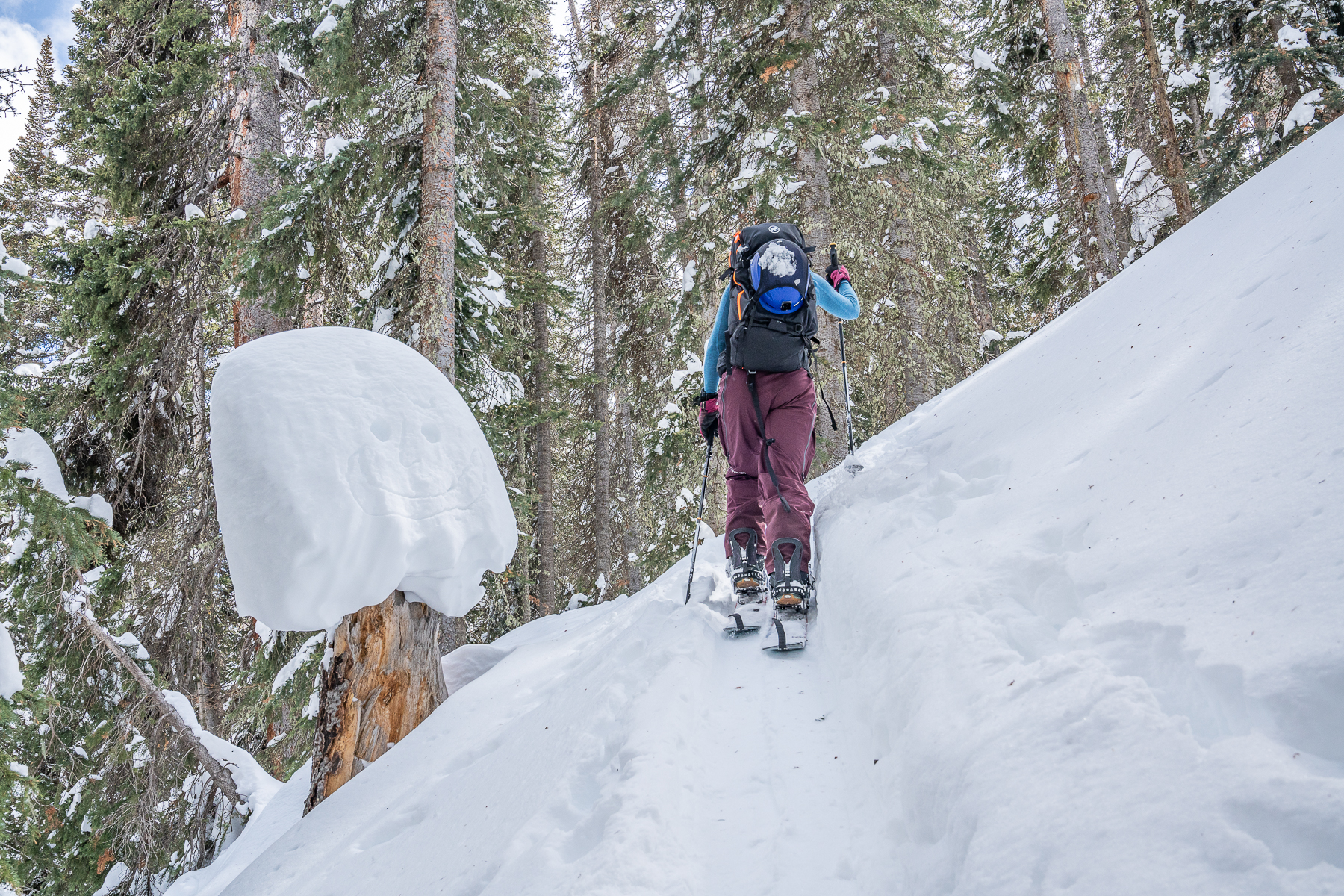
An avalanche airbag pack combines a traditional backcountry pack with an inflatable airbag system.
For the most part, each brand has its own unique pack design that’s paired with an airbag system, which all function similarly and for the same purpose: to help protect a winter traveler in the event of an avalanche.
Airbag system designs are proprietary and can be developed through a partnership or licensed between brands. For instance, Arc’teryx and Ortovox teamed up to develop the lightweight LiTRIC avalanche airbag system, which each brand utilizes in its own pack line, that launched in fall 2022.
When the rider or skier is caught in an avalanche, they need to manually release an inflatable airbag, which fills up through compressed air or gas or via an electric fan. When the airbag explodes through the top of the pack, the firm cushion surrounds the head and neck to help prevent trauma.
The airbag also helps the skier or rider stay atop the moving snow. After the snow settles, the airbag can also potentially keep snow from blocking the victim’s airway.
For resort days, it’s nice to have a snack, some water, and room to stash a layer you may remove as the day heats up. And it’s never a bad idea to have a small first-aid kit and repair tool.
If you’re heading out of bounds, you’ll need more. In addition to a good pack with the right capacity and features, the list ranges from a down jacket, extra goggles, and ski straps to your shovel and probe. We’ve dedicated an entire article to the gear you need to start backcountry skiing.
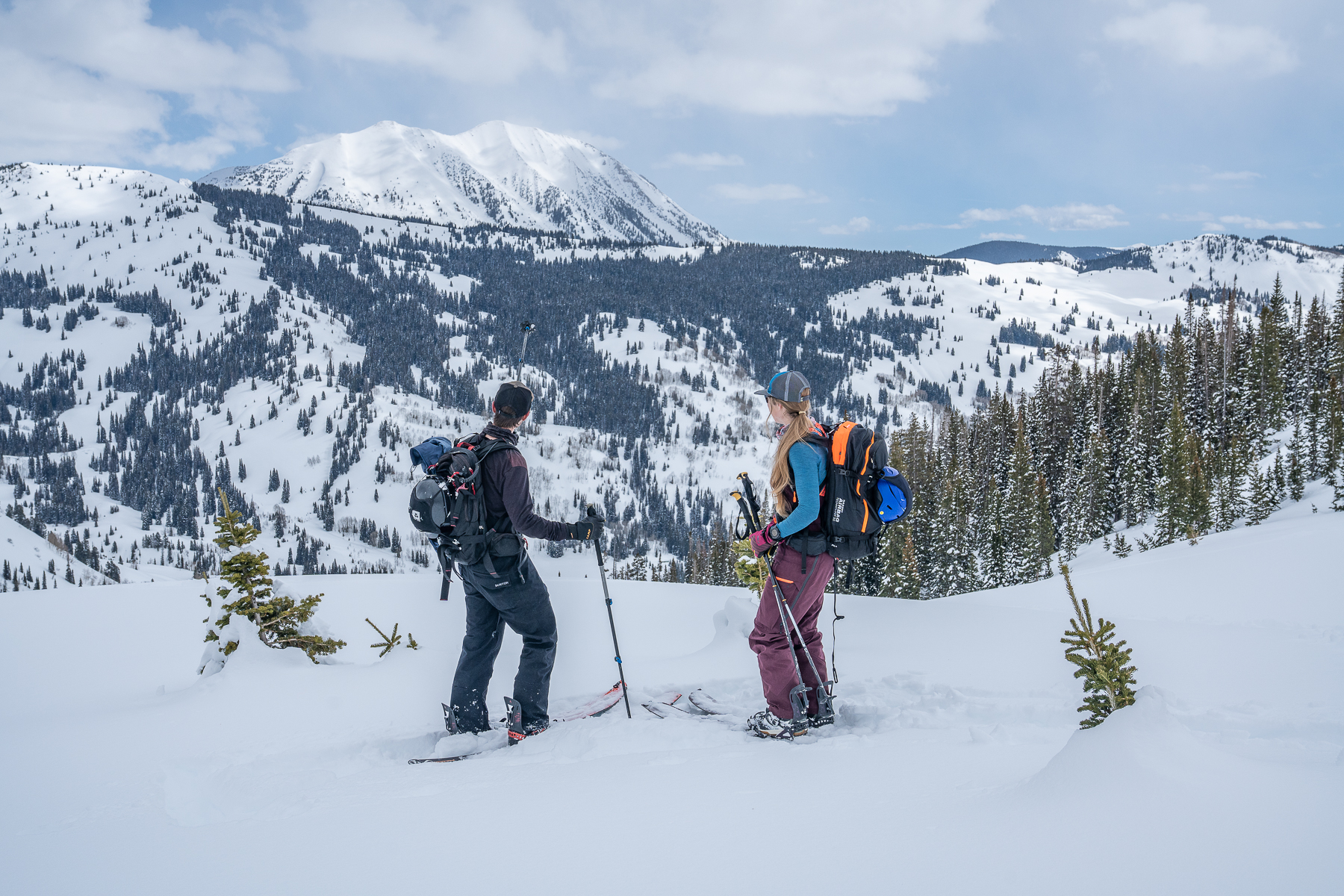
While this varies depending on your adventure plans and gear needs, sub-20L packs are ideal for resort skiing and riding, uphilling, or skimo races. Some of these compact packs even have a ski and snowboard carry, which is a nice feature for hike-to in-bounds terrain.
A pack from 20 L to 35 L that can schlep more is ideal for side-country, backcountry, and gear-intensive trips. Some pack designs in the 30-35 L realm are also designed to support ski and splitboard mountaineering expeditions. Packs from 40 L to 50 L are more stout for backcountry overnight missions and hut trips as well as mixed alpine and mountaineering ascents.
When you pack for a backcountry ski or splitboard day, first put your shovel and probe into their proper pockets inside their designated spots. Usually, it’s most comfortable to put heavier and lesser-used items toward the bottom of the pack, like a first-aid kit, repair kit, or an extra down jacket and beefy gloves.
Make sure you keep your snacks in places you can quickly access while you’re on the skin track, so you can continue to take down fuel as you venture. Likewise, you’ll want your water in an accessible place. Sometimes that’s in a hydration bladder or in a water bottle that fits along the side of the pack next to a zipper entry so you can quickly grab and sip.
Battery packs, extra batteries for your beacon, or headlamps are nice to keep in a protective zip-enclosed pocket. If the backpack doesn’t have one, you can put those items in a tiny dry bag and put it toward the middle or bottom of the backpack. Of course, it’s a good match to put an extra pair of goggles or sunglasses in the goggle pocket.
Toward the top of the pack or in external pockets, you’ll want the layers you’ll most likely be rotating through, like a fleece or buff.
You’ll also want your downhill gloves or mittens toward the top of your pack, so you can put them on right away during a transition, especially if the temps are frigid or there’s windchill.
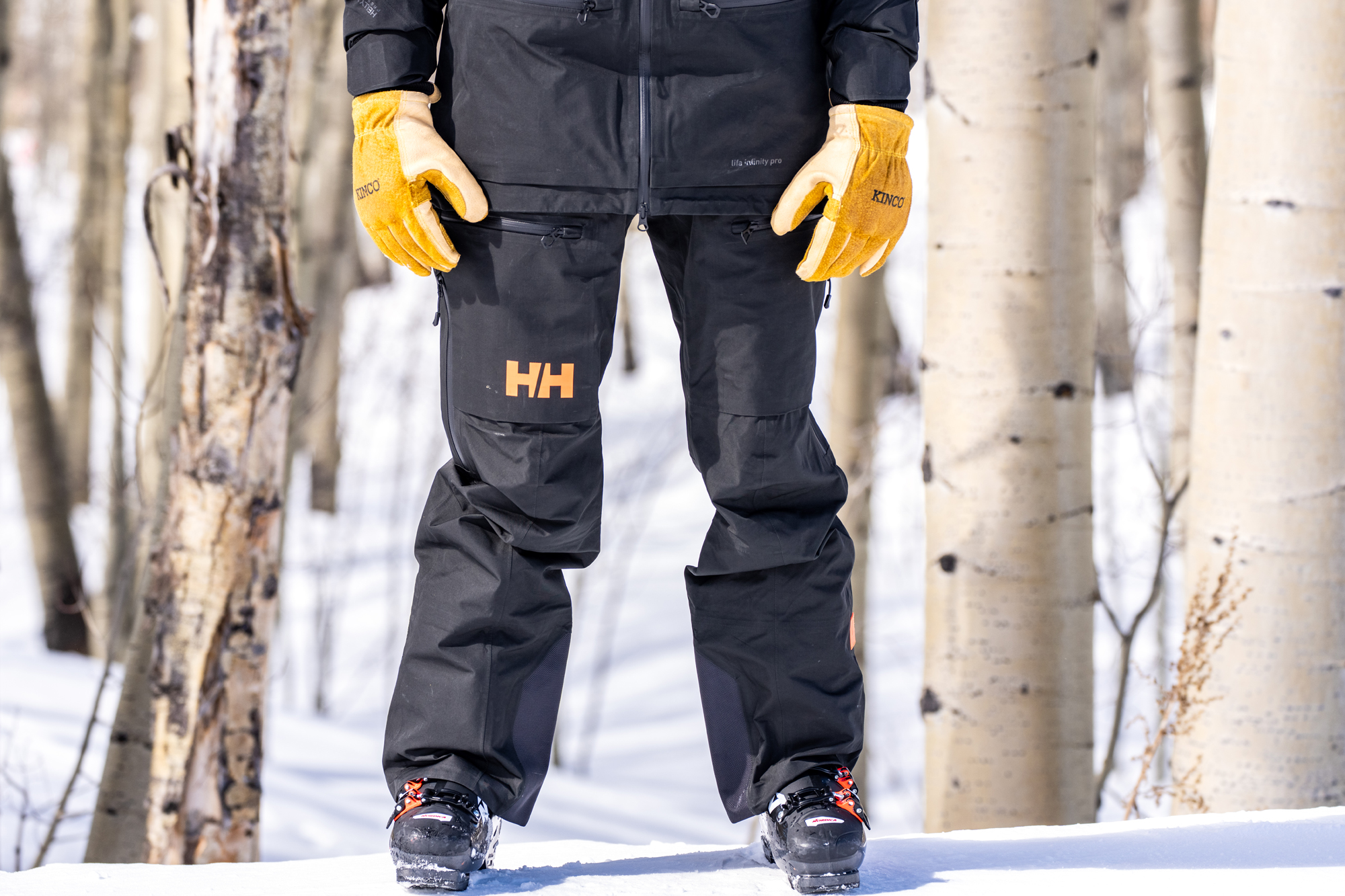
The Best Ski Pants of 2025-2026
For the resort or backcountry, we found the best ski pants for a range of conditions including Flylow, Patagonia, Rab, and more.
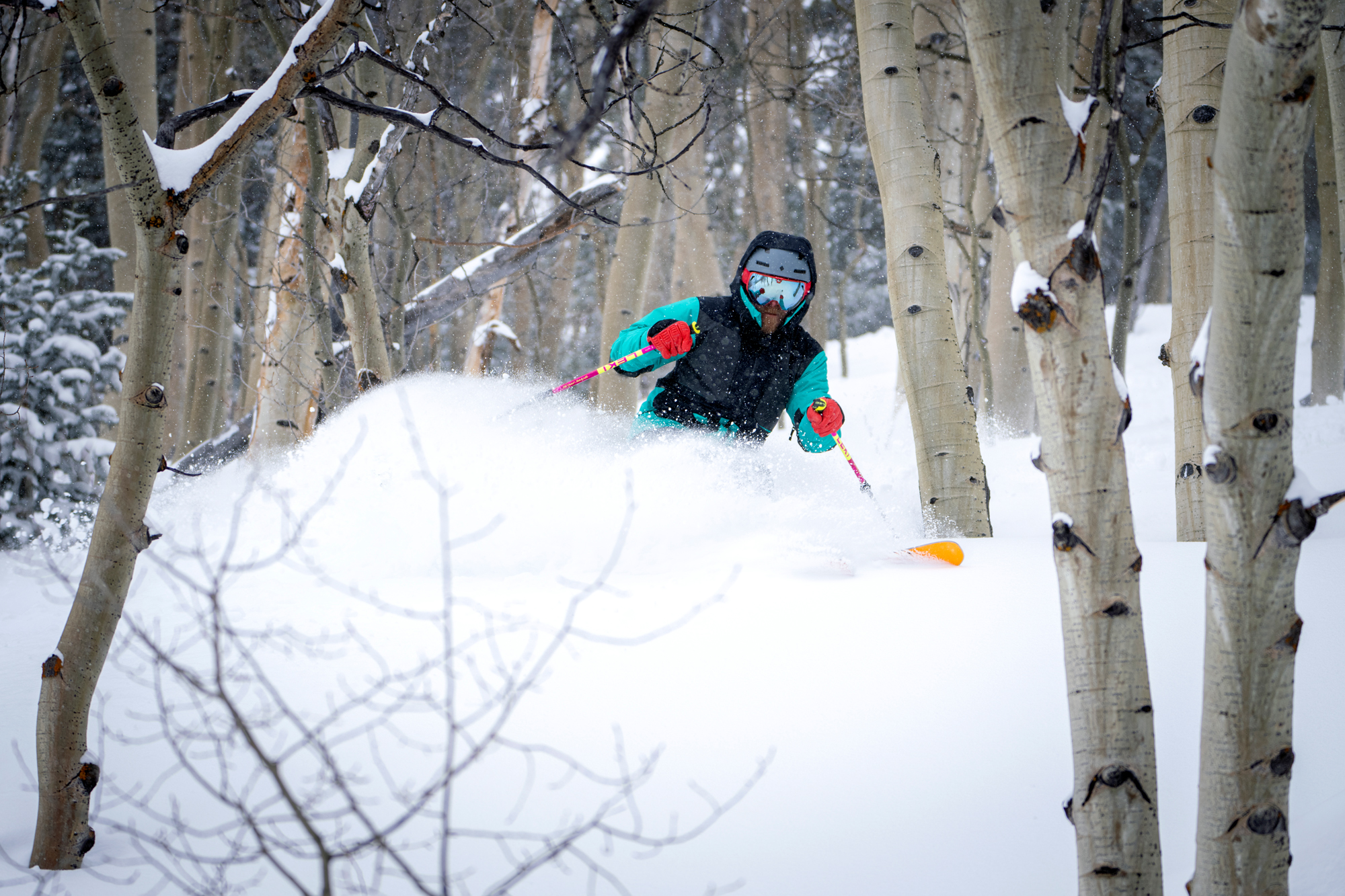
The Best Ski Jackets of 2025-2026
Whether you’re skiing in sunny or stormy conditions, we tested and found the best ski jackets including Patagonia, Arc’teryx, and more.
